

Nirvana Film Studio by Shimul Javeri Kadri: Connecting Cinema and Architecture

The veteran architect, Ar. Shimul Javeri Kadri has been setting standards and changing the perspective of design practices since 1997 when she set up her architectural firm SJK Architects . The firm has an energy-conscious design approach where sun, wind, and nature can be used as an advantage. Her designs incorporate sustainability , natural materials , local construction techniques, and a user-centric approach . The firm has won various national and international awards, including Prix Versailles Award, 2016, and World Architecture Festival Award, 2012.

This project, Nirvana Film Studio , is an office space for an ad film production company, designed and built in 2011 in Bangalore city in an approximate area of 8000sq.ft. The ad film company which has produced ads like the Vodafone Zoozoos and Incredible India thinks outside the box and needed spaces that could enhance their creativity and reflect a similar approach. The design team achieved an 8000sq.ft. built-up area on a site of 3000sq.ft. Allowable Floor Space Index (FSI), site setbacks, and optimizing spaces enabled the team to achieve this built-up area. The budget of this project was approximately 2.25 crores including all services and interiors.
Design Philosophy

The requirement of the client was a space that would enhance the creative bends of the employees and not a space that would create a formal corporate environment. Space was required that would help the employees focus on their work and simultaneously relax them as well and provide a positive environment. The design concept for this workspace is based on the thought that the connection of synapses creates ideas — not privacy or isolation.

This building is a box-shaped structure that is placed in a small corner plot in the busy area of Indiranagar, Bangalore. Since it was a corner plot, open along its south and west side, a design core in form of a center staircase acting as a north-south connector slicing the building was provided with a huge skylight above it. Just like a courtyard , in another type of project, the center design core provides natural light and ventilation to space, creating a relaxing and nature-interactive environment. Despite the constraints of the real estate, this project is so designed that this building uses almost no electricity for its lighting and ventilation.

The facades create a blur between inside and outside, work and non-work spaces. The mixed-use of fixed glass and openable acrylic louvers that modulates light, wind, and rain connect the interior spaces with the outside environment making the spaces visually merge into each other. The notion of wall and window are interchanged on this dynamic façade as the walls are open and the windows are solid.
The staircase needed a flexible permeable device to block rain and allow light and wind. An 18’ high wood and clear acrylic jail made up of 6” wide louvers interlocked with each other was installed so that they could move together to naturally ventilate the stairwell.

Energy Efficiency
Architect Shimul Javeri Kadri designed the building in such a way that the building used almost no electricity for ventilation and lighting. There is no HVAC system installed in the building except for the post-production space where machinery and computers heat the space and need an extra cooling system. Natural lighting is enough for lighting during the daytime but a proper artificial lighting system has been installed for late working hours. Fluorescent tube lights are installed in the task-oriented spaces whereas LEDs in the multifunctional relaxing spaces.
Rainwater is collected from the roof-top and channelized through pipes towards the borewell that helps to recharge the underground water. Rainwater from the west side is collected in a pond on the stilt level and used for landscaping. To reduce water consumption and wastage dual flush mechanism tanks and sensor taps are used.

There are three main materials used in the building: wood, glass, and concrete, keeping the structure light and raw. The building roof is a concrete soffit slab as there is no false ceiling or any gypsum boards, thus reducing the cost of construction. RCC flat slabs for the roof, waterproofed in brickbat Coba with cement screed as top coat forming thread cut panels, were inclined to take into consideration the rainwater downtake pipes. The top surface has an additional white thermoplastic coating to reflect the heat, which helps to maintain an ambient temperature of the floor below.
The flooring is made out of in-situ grey cement polished with in-situ oil. Granite stone is used for stilts and black granite in bathrooms. Special care has been taken to avoid any sort of wastage and every piece of stone is used either on the floor or as the dado. The walls are made water-resistant by executing a backing coat of cement plaster with white cement-based putty that binds the base plaster avoiding the pain of being flaky even when walls are damping.

The furniture used in this building is all locally refurbished and reused. Even the doors and windows in this building are old salvaged furniture acquired from local markets. Old Burma wood is used for treads and seats and all the other small furniture like dustbins, mats, etc are made of reusable materials like bamboo and banana fiber.

Landscaping

Native plants like Bamboo, Foxtail Palms, Ficus tree, and Heliconias are grown as they consume less water and are easy to maintain in their local habitats. The existing Mango Tree on the site is integrated with the service staircase. The wet garbage from the building is processed into vermicompost and manure which is used for landscaping.

- sjkarchitect. (n.d.). SJK Architects | Office for a Production studio. [online] Available at: https://www.sjkarchitect.com/nirvana-films [Accessed 21 Jun. 2021].
- Evans, H. (2013). A Different Working Space – Nirvana Film Office. [online] Nimvo – Interior and Exterior Design, Architecture, Home Tips. Available at: https://nimvo.com/a-different-working-space-nirvana-film-office/ [Accessed 21 Jun. 2021].
- Tropical Architecture. (n.d.). OFFICE SPACE FOR NIRVANA FILMS. [online] Available at: http://tropical-architecture.blogspot.com/2012/03/office-space-for-nirvana-films.html?m=1 [Accessed 21 Jun. 2021]
- www.surfacesreporter.com. (n.d.). Projects with Solid Surfaces by Architects: Shimul Javeri and Santha Mattoo. [online] Available at: https://www.surfacesreporter.com/articles/20804/project-with-solid-surfaces-by-architects-shimul-javeri-and-santha-mattoo [Accessed 21 Jun. 2021].
- ArchDaily. (2013). Nirvana Film Office / SJK Architects. [online] Available at: https://www.archdaily.com/356876/nirvana-film-office-sjk-architects [Accessed 21 Jun. 2021].
- CAANdesign | Architecture and home design blog. (2015). Nirvana Film Office by SJK Architects. [online] Available at: https://www.caandesign.com/nirvana-film-office-by-sjk-architects/ [Accessed 21 Jun. 2021].
- Architizer. (2014). Nirvana Films Office by SJK Architects. [online] Available at: https://architizer.com/projects/nirvana-films-office/ [Accessed 21 Jun. 2021].
- May 18, A.P., May 28, 2018 I.D., May 18, 2018UPDATED: and Ist, 2018 16:18 (n.d.). Architecture is a collaboration with people, ideas and attitudes: Shimul Javeri Kadri. [online] India Today. Available at: https://www.indiatoday.in/magazine/supplement/story/20180528-architecture-is-a-collaboration-with-people-ideas-and-attitudes-shimul-javeri-kadri-1236202-2018-05-18 [Accessed 21 Jun. 2021].
- www.surfacesreporter.com. (n.d.). Architect Shimul Javeri Kadri, Founder, SJK Architects, Mumbai. [online] Available at: https://www.surfacesreporter.com/articles/51549/architect-shimul-javeri-kadri-founder-sjk-architects [Accessed 21 Jun. 2021].

Rhythm is an architect and a design enthusiast. She believes in responsible designing as architecture has a great impact in shaping the society. She likes to explore different roles and opportunities related to architecture, writing being one of them.
SUGO- 10 Iconic Products

Campus Life at Indian Institute of Technology Kharagpur
Related posts.

Case Studies in Experiential Architecture

The Story Behind Beirut Terraces

The Sunsphere, Knoxville, Tennessee

Kalyon Karapınar 1.350 MWp SPP – Central Control Building by Bilgin Architects

Sheikh Zayed Grand Mosque, Abu Dhabi

Museum of Art & Photography, Bangalore
- Architectural Community
- Architectural Facts
- RTF Architectural Reviews
- Architectural styles
- City and Architecture
- Fun & Architecture
- History of Architecture
- Design Studio Portfolios
- Designing for typologies
- RTF Design Inspiration
- Architecture News
- Career Advice
- Case Studies
- Construction & Materials
- Covid and Architecture
- Interior Design
- Know Your Architects
- Landscape Architecture
- Materials & Construction
- Product Design
- RTF Fresh Perspectives
- Sustainable Architecture
- Top Architects
- Travel and Architecture
- Rethinking The Future Awards 2022
- RTF Awards 2021 | Results
- GADA 2021 | Results
- RTF Awards 2020 | Results
- ACD Awards 2020 | Results
- GADA 2019 | Results
- ACD Awards 2018 | Results
- GADA 2018 | Results
- RTF Awards 2017 | Results
- RTF Sustainability Awards 2017 | Results
- RTF Sustainability Awards 2016 | Results
- RTF Sustainability Awards 2015 | Results
- RTF Awards 2014 | Results
- RTF Architectural Visualization Competition 2020 – Results
- Architectural Photography Competition 2020 – Results
- Designer’s Days of Quarantine Contest – Results
- Urban Sketching Competition May 2020 – Results
- RTF Essay Writing Competition April 2020 – Results
- Architectural Photography Competition 2019 – Finalists
- The Ultimate Thesis Guide
- Introduction to Landscape Architecture
- Perfect Guide to Architecting Your Career
- How to Design Architecture Portfolio
- How to Design Streets
- Introduction to Urban Design
- Introduction to Product Design
- Complete Guide to Dissertation Writing
- Introduction to Skyscraper Design
- Educational
- Hospitality
- Institutional
- Office Buildings
- Public Building
- Residential
- Sports & Recreation
- Temporary Structure
- Commercial Interior Design
- Corporate Interior Design
- Healthcare Interior Design
- Hospitality Interior Design
- Residential Interior Design
- Sustainability
- Transportation
- Urban Design
- Host your Course with RTF
- Architectural Writing Training Programme | WFH
- Editorial Internship | In-office
- Graphic Design Internship
- Research Internship | WFH
- Research Internship | New Delhi
- RTF | About RTF
- Submit Your Story
Looking for Job/ Internship?
Rtf will connect you with right design studios.

- Hispanoamérica
- Work at ArchDaily
- Terms of Use
- Privacy Policy
- Cookie Policy
- Educational Architecture
- United States
Pratt Institute's New Film/Video Department Building / think!

- Curated by ArchDaily
- Architects: think! : think!
- Area Area of this architecture project Area: 15000 ft²
- Year Completion year of this architecture project Year: 2015
- Photographs Photographs: Alexander Severin

Text description provided by the architects. Unveiled in Spring 2015, Pratt Institute’s new Film/Video Department offers students a cutting-edge facility boasting 3,000 square feet in soundstage space including an infinity green screen, a 96-seat screening room with surround sound, a sound recording studio, and two high-end post production suites. Located on Pratt’s Brooklyn campus at 550 Myrtle Avenue, the 15,000-square- foot, two-story building was formerly the home of the PrattStore.

The design team, headed by Pratt alumnus Jack Esterson, focused on honoring the expansive, open quality of the building. Built using free-span trusses, the interior space is column-free and features 23-foot high ceilings. Specially-created by Pratt alumnus and Architecture Professor Haresh Lalvani, a stunning series of perforated, sculptural metal panels wrap around the entrance lobby and envelop rooms requiring sound-proofing and darkness.

A floating bridge spans over the building’s first floor and connects classrooms and offices on the second floor while various interstitial spaces throughout serve as dynamic social areas for students to meet and interact. The design is intended to foster “the spirit of students learning from each other” and create “a vibrant and collaborative filmmaking environment,” Esterson explains.

Sustainable and eco-friendly components of the project include high-efficiency LED lighting and the re-use of pre-existing construction features from the original building including stairs and ductwork.

Within one year of opening, the Department’s five-year plan to double enrollment was realized. The project was recognized with a citation award in the 2015 American Institute of Architects New York State Design Awards.

Project gallery

Project location
Address: 550 myrtle avenue, brooklyn, ny 11205, united states.

Materials and Tags
- Sustainability
想阅读文章的中文版本吗?

Pratt学院新电影/影像学院大楼 / Wasa/Studio A
You've started following your first account, did you know.
You'll now receive updates based on what you follow! Personalize your stream and start following your favorite authors, offices and users.
Check the latest Desks Privacy Furniture
Check the latest Desks Bureaus

Amazing Architecture
- {{ post.title }}
- No result found
- Skyscrapers
- Bollywood Heights, A Film City Tower at Mahim Bay, Mumbai de...
Bollywood Heights, A Film City Tower at Mahim Bay, Mumbai designed by Doodle Studio
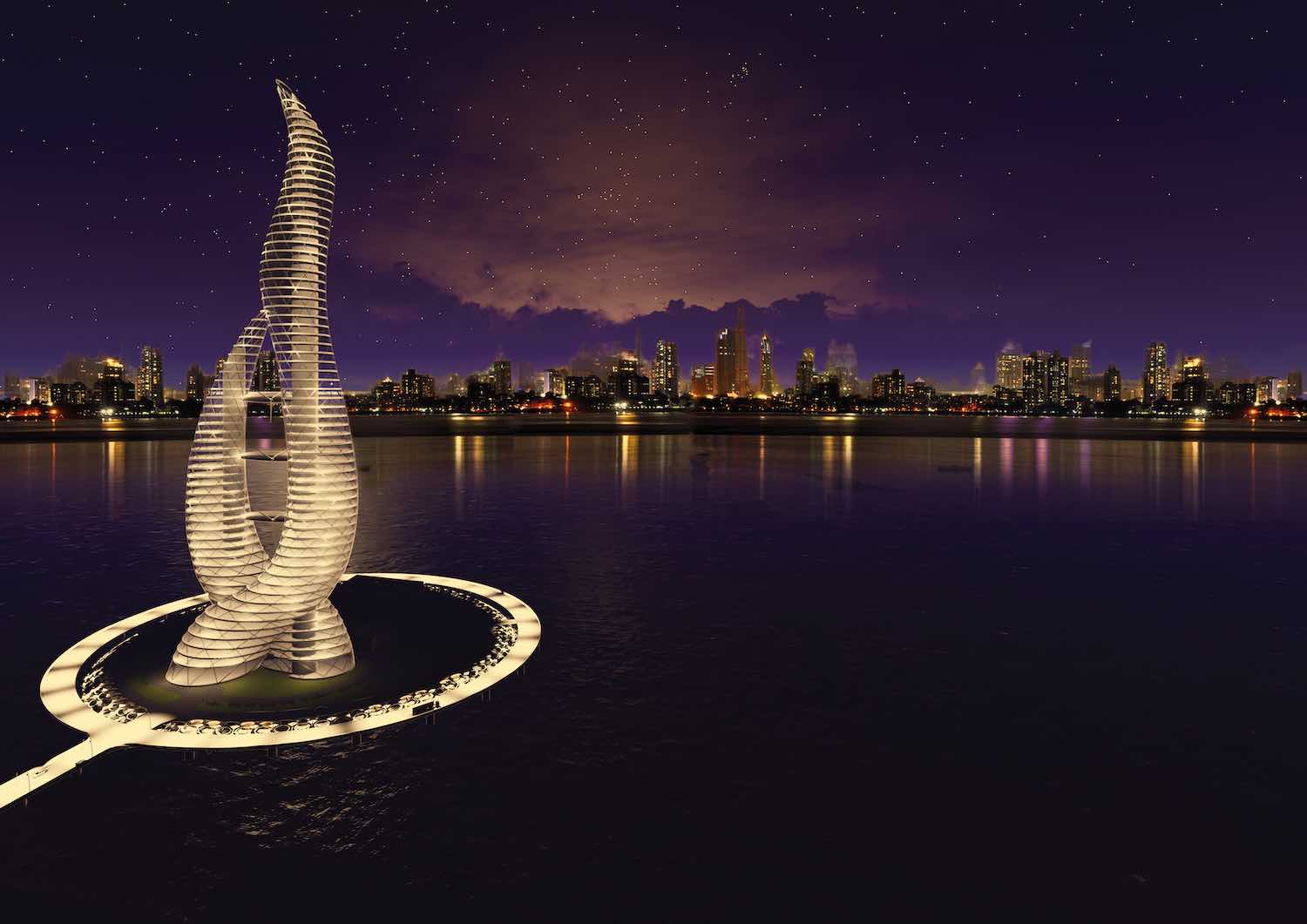
The Indian architect Vaishaly from Doodle Studio has designed ''Bollywood Heights'' a proposal for a vertical film city. The setting of this story is in the Mahim Bay, a bay that is a part of the Arabian Sea in Mumbai . This tower stands on an artificial island as a net-zero energy building it will be self-efficient to generate energy for its use and will also help in cleaning water of the Mahim Bay.
Project description by the architects:
Introduction
Pacing along the kutchha streets of Indian villages to the high end roads and flyovers of metropolitan cities, we never fail to get the reflection of India’s most influential industry called Bollywood . Be it the blockbuster movie poster hoardings near traffic lights, or the Bollywood star brand endorsements on flexes in front of our favourite gol gappa stalls, Bollywood is found everywhere in India. Bollywood, a term used to refer to the whole of Indian cinema, has been in the hearts of Indians from over a hundred years.
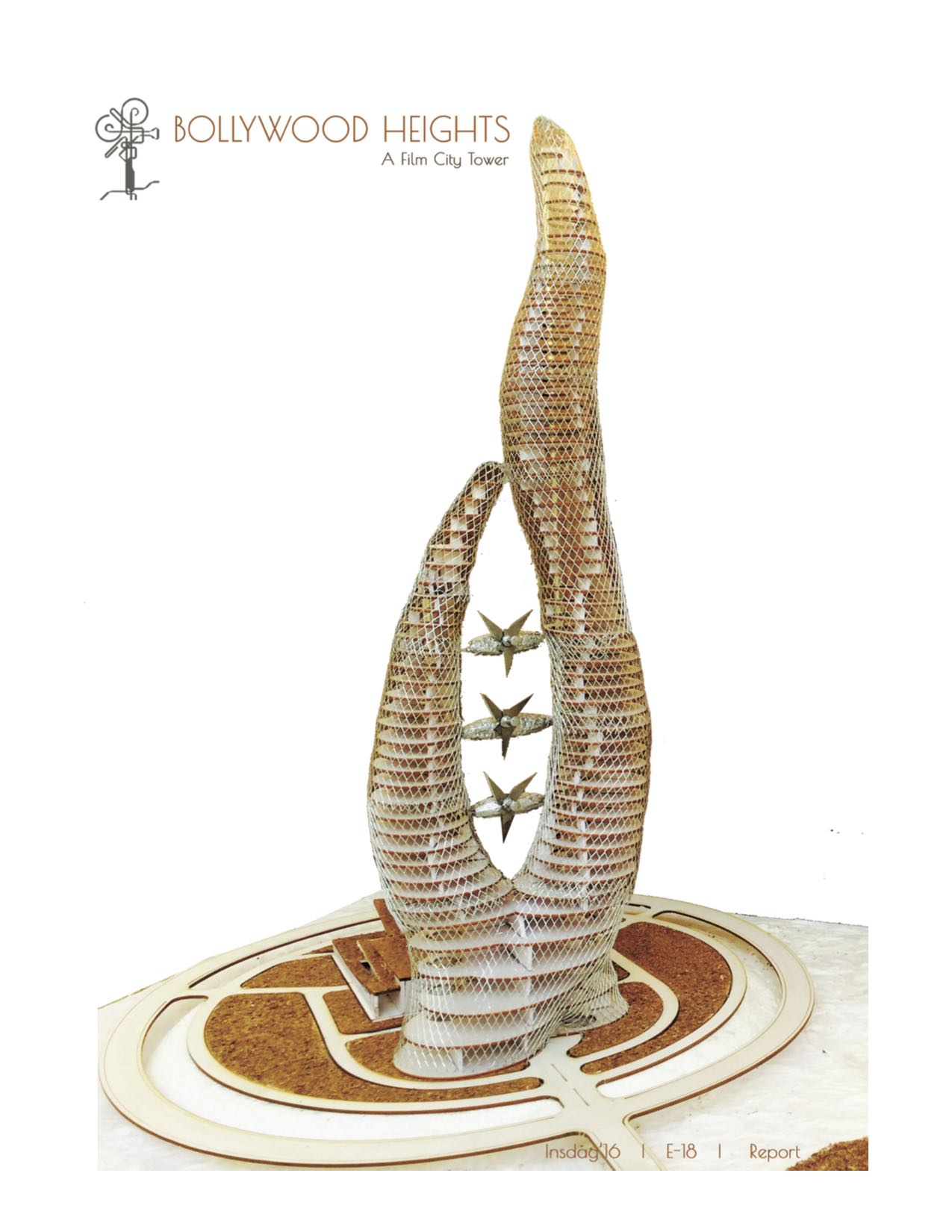
‘Bollywood Heights’ is a design proposal for a vertical film city under the cover of a thesis project. The setting of this story is in the Mahim Bay, a bay which is a part of the Arabian Sea in Mumbai. This project will fulfil all the challenges and space requirements of a horizontal film city, in a vertical fashion, without causing the problem of availing real estate in the highly occupied city of Mumbai. This city is the home of Bollywood, where billionaire stars to struggling actors, all reside to work for the industry. The surrealism surrounding Bollywood is almost synonymous with the cultural ethos and is ingrained in the aspirations and lifestyle of common people across India. It has the emotional power to sway and swing millions of people. Bollywood is a goliath in terms of revenue generation and employment, both direct and indirect, supporting a multitude of auxiliary industries like tourism, music, design and fashion, being a significant contributor to the national GDP. Also standing as a net-zero energy consuming building it will be self-efficient to generate energy for its use and will also help in cleaning the water of the Mahim Bay.

Wikipedia states “A film studio (also known as movie studio or simply studio) is a major Entertainment Company or Motion Picture Company that has its own privately owned studio facility or facilities that are used to make films, which is handled by the production company.” A film studio consists of all the equipment and facilities required for pre- production, production and post-productions plus a primer theatre.
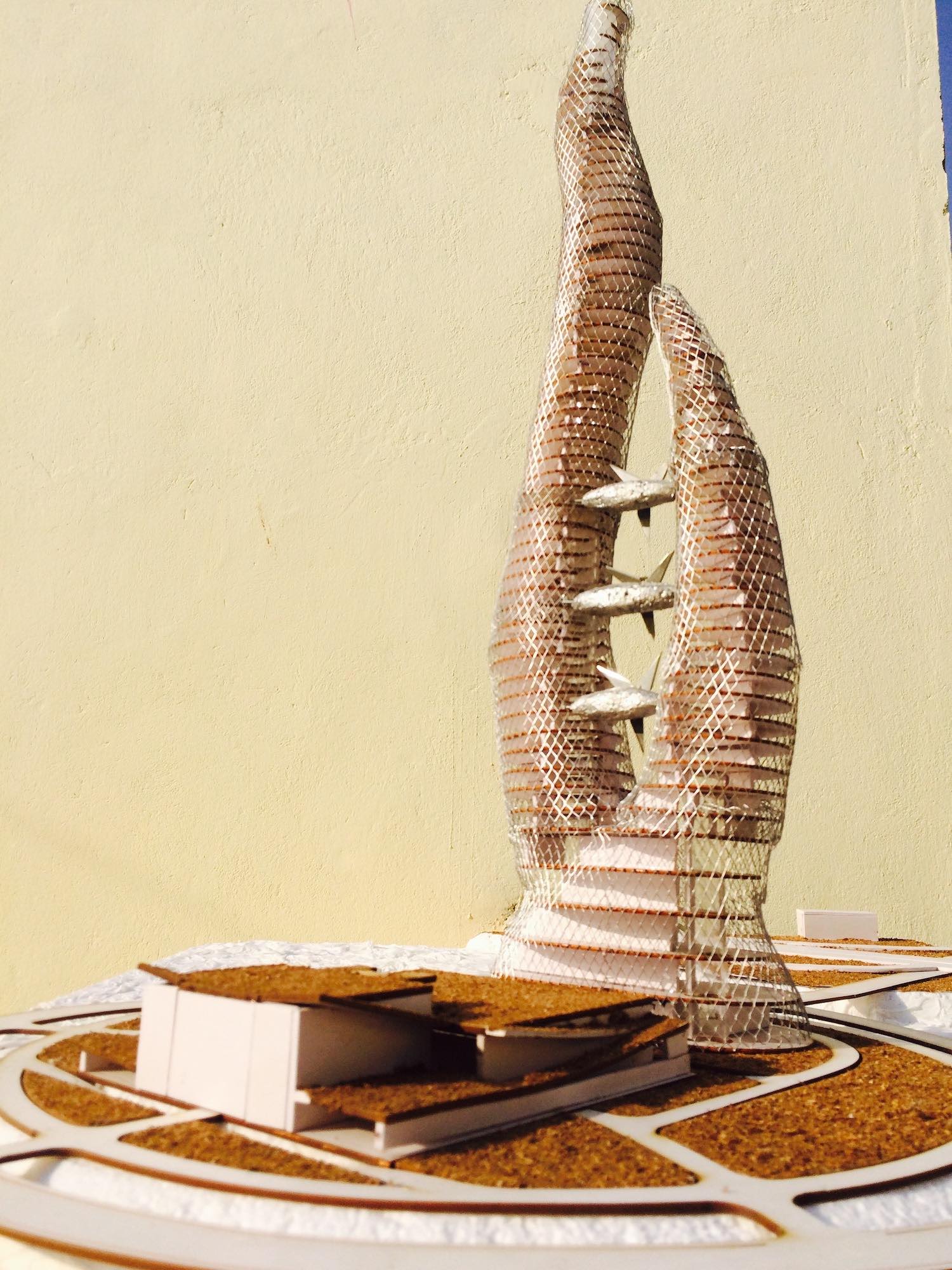
Film studios, in their inception, have had only indoor and outdoor shooting facilities. The advancement of technology brought major changes in the field of film making. Animation techniques, such as green screen technology and development of sound system, have given the touch of reality. In film studio, we can find all the facilities required which include office spaces, residence facilities for actors and other technicians. In a film studio one can shoot a movie in a very fast pace as one can construct different indoor and outdoor scenes quickly by using the workshop facilities available.
Bollywood, since a while, has needed both an iconic status that can be physically appreciated along with more facilities to accommodate budding film-makers.
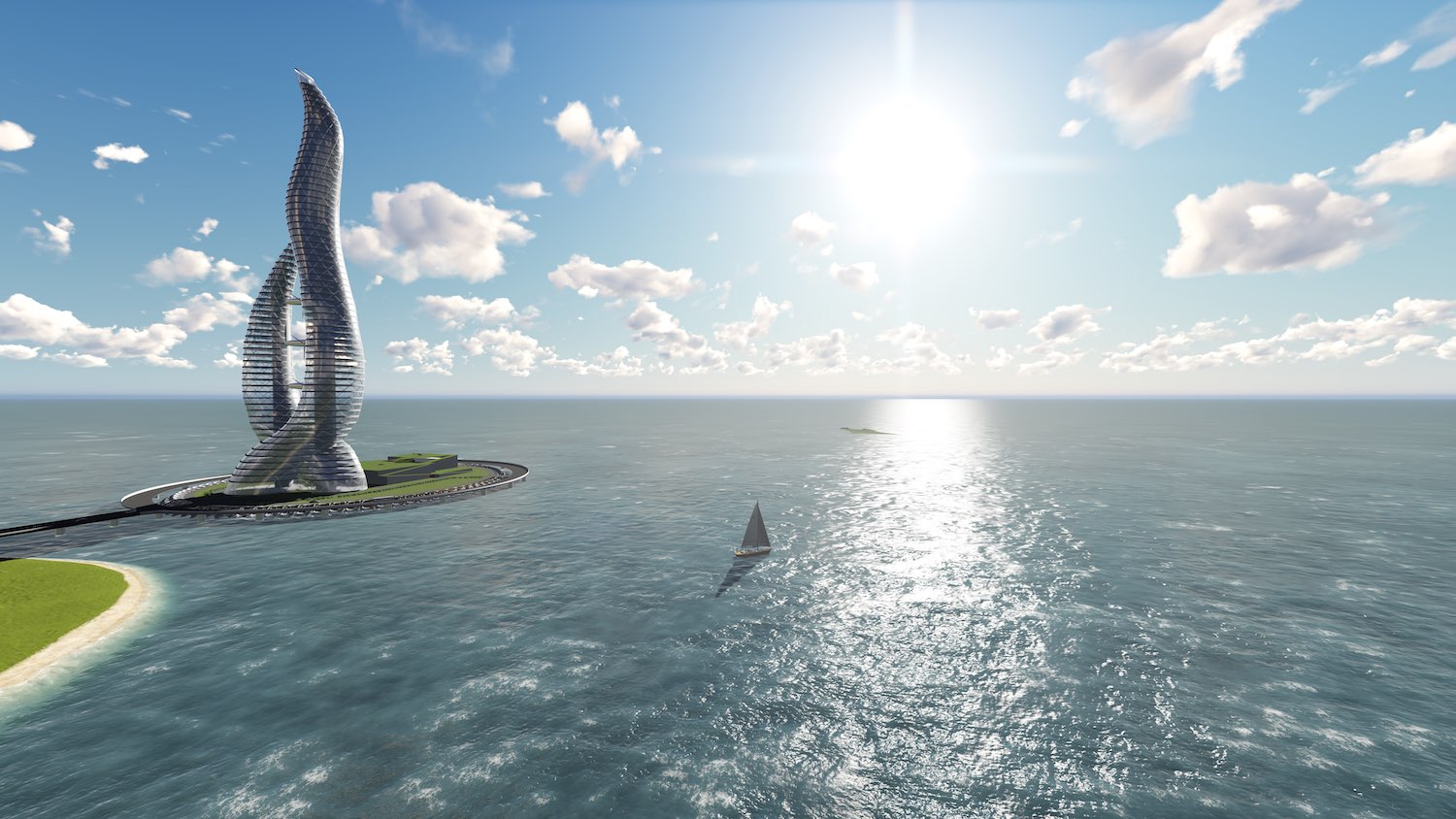
Need for a Vertical Film City
Verticality achieves a few things by the virtue of its height alone. It becomes a visual icon and saves ground cover. These ideas have been virgin to the film studio layouts as they have never been stacked in a vertical tower. But if in place like Mumbai, where there is a constant scarcity of land and is also a place for sporting high-rise towers for the nation, the proposal and need arise and complement each other.
The aim is to identify the land and service intensive functions of a film city while compacting and transforming them into a vertical tower that would generate an exemplary urban form. It is needed today in a time of land scarcity and technological advancement. A challenging and compelling design can always push forward the creativity in architecture.
It should firstly have an identity, secondly tackle all city problems and enrich the life of the residents around it. The centre has multiple land use, which can broadly be categorized into commercial, educational, recreational and public building therefore integrating and unifying common interests. All such requirements in a Mumbai site can be reflected as an efficient design programme where parking podiums, high-rises, mixed-use buildings and film making are common place.
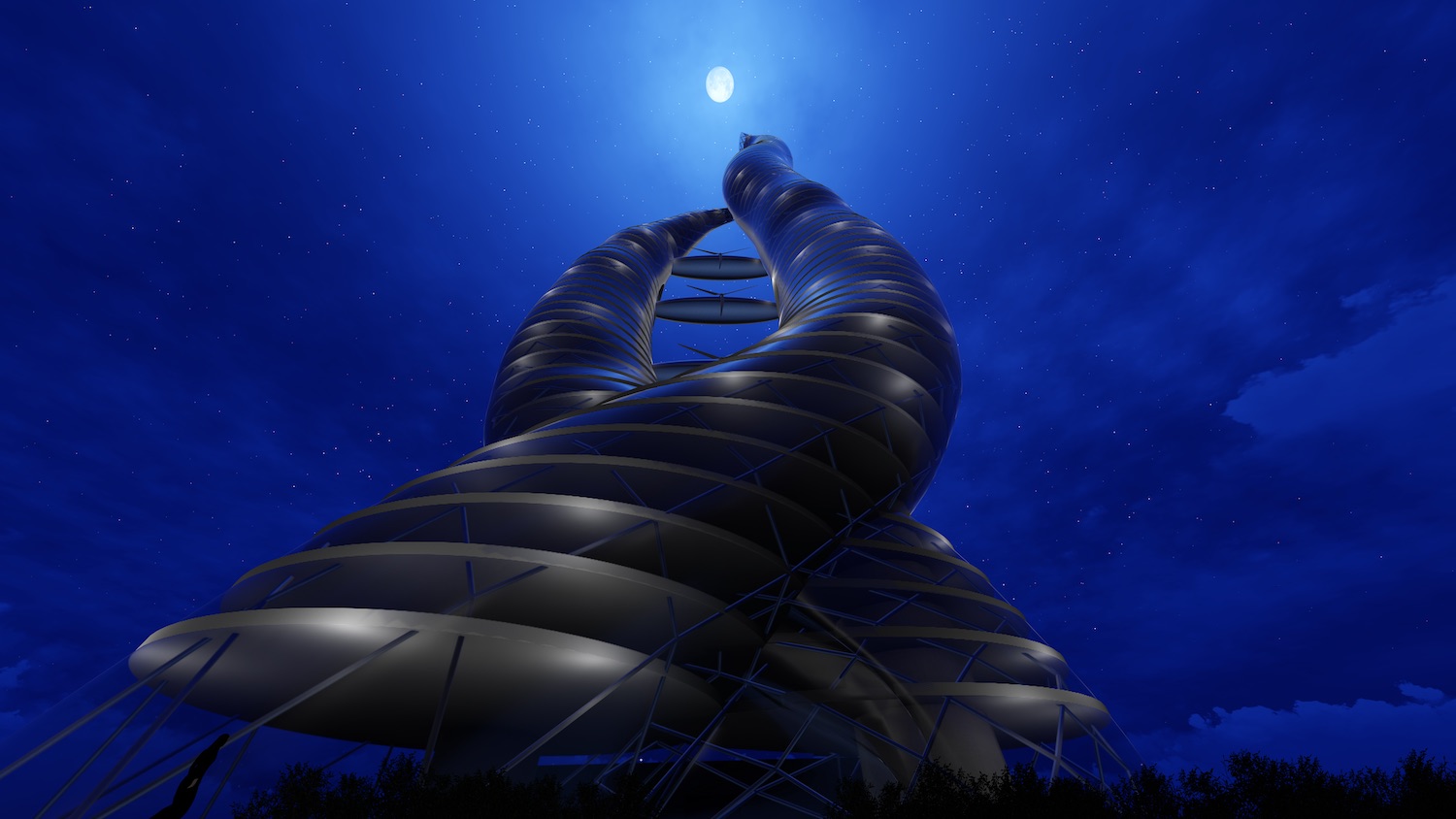
Proposition
BOLLYWOOD FILM CITY TOWER, MUMBAI EXPLORING A VERTICAL TYPOLOGY FOR A FILM CITY
To design a ‘Film City Tower’ in Mumbai that explores the possibility of a new vertical typology for a film city creating an iconic landmark for Bollywood and its city.
The thesis is thus an attempt to answer: What Makes an Iconic Film City? How Can a Film City be planned vertically?
The three nodes of this design proposition fall in place with each other where the Bollywood Film City’s need for an icon is complemented with an architectural challenge of exploring a vertical typology for a film city. And the need for such a high-rise project is common in Mumbai which is incidentally the focal point for Bollywood is making this conceptual project feasible by choosing it as a site.
Site: An artificial island in Mahim Bay, Mumbai. Source: Yamaha Corporation via an open international competition hosted by Archasm.
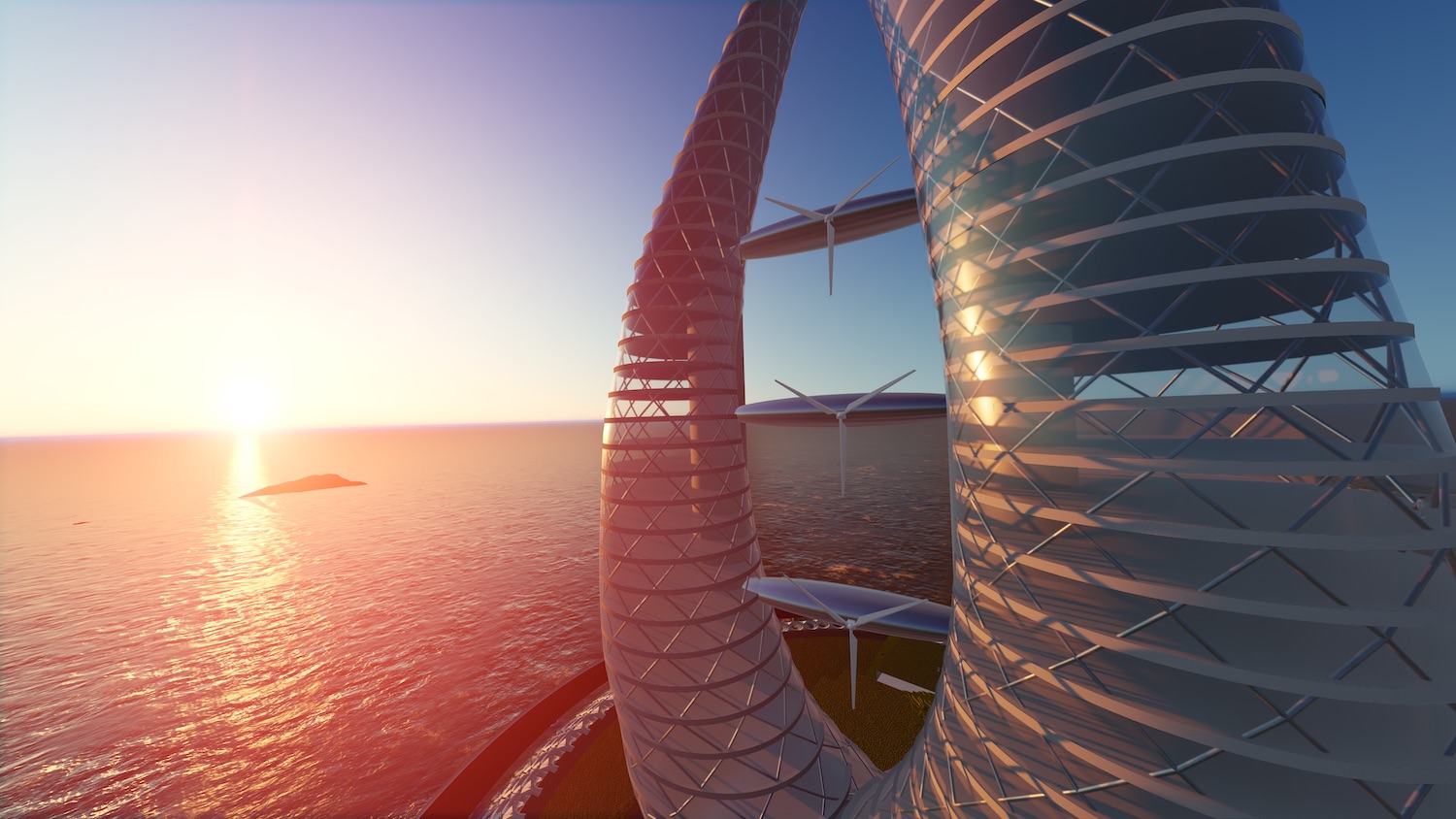
Aims and Objectives
Translation and appropriation of the components of a Film City in an innovative vertical tower typology Creation of a contemporary icon for Bollywood and the city of Bombay The Film City Tower aims to provide some necessary facilities that a fully functional film city requires.
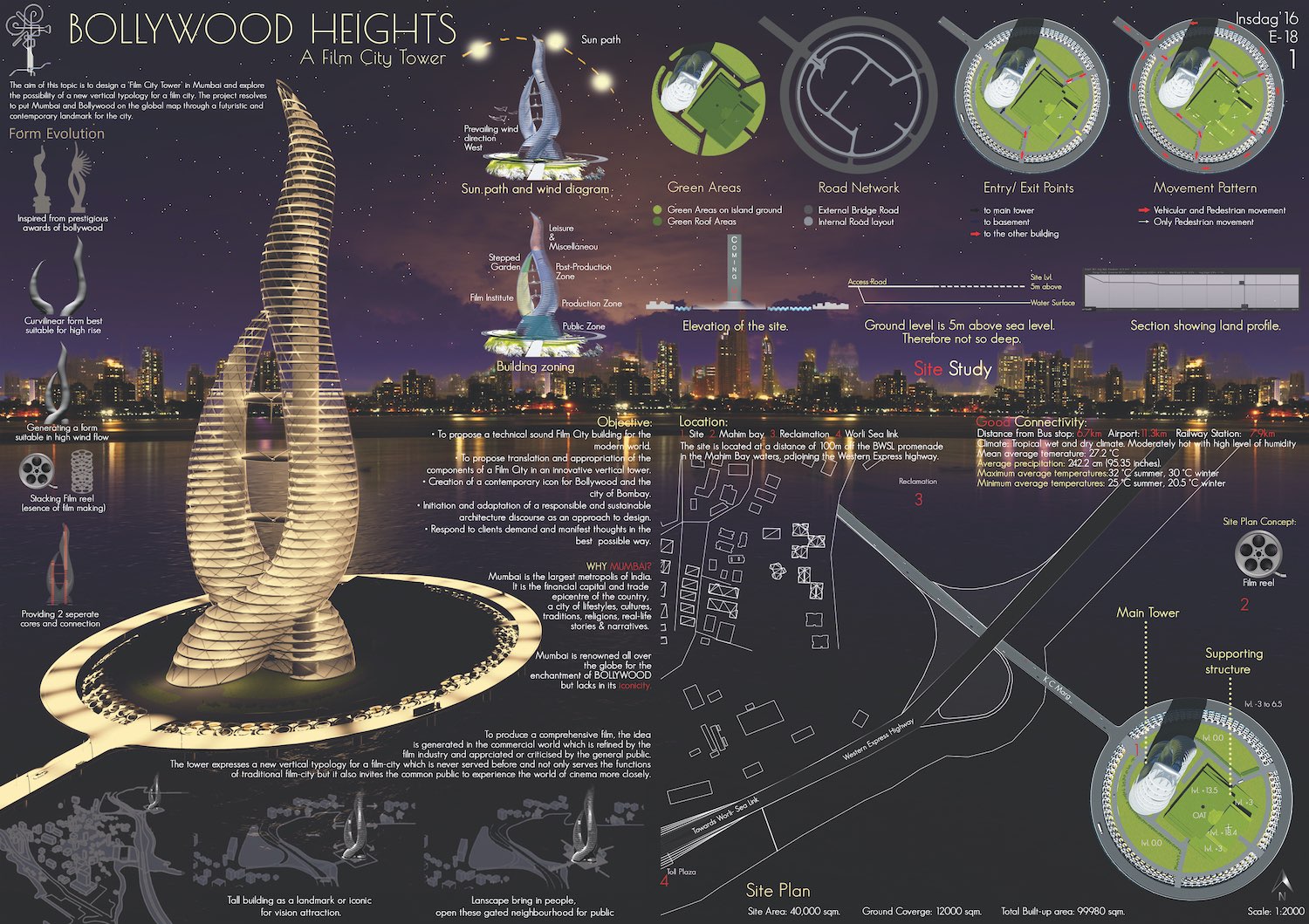
Scope of Work:
FILM PRODUCTION •Sound Stages •Production Accommodation- Make-Up Rooms, Costume/Wardrobe facility, Dressing/Changing Rooms, Arts Department, Workshops(plastering, carpentry, props, paint, steel work etc.), Utility/Storage, Actors’/Producers’ Rest rooms, Lounge areas for junior artists etc. •Post Production- Video Editing studios (linear/non-linear editing rooms, online/offline editing rooms, VTR rooms, VFX production room, Colour Grading studios), Recording theatres, Audio Editing studios (Foley studios, Dubbing studios, Re - Recording studios), Screening theatres, Archival and Restoration facility, Media Transfer facility. FILM SCHOOL Shooting Floors, Acting studios, Dubbing studio, Photography studio, Multimedia laboratory, Library, Auditorium/Theatre, Dance/Music studios, Equipment laboratory, Cafeteria, Workshops, Reception and Conference area, Faculty rooms etc. SOCIAL AND LEISURE/MISCELLANEOUS Bollywood Museum, Movie theatres, Exhibition areas, Cafes, Restaurants, Retail and Tuck shops, Children’s gaming and play zones, Administrative areas, Vertical circulation cores, Landscape zones and other types of gathering spaces etc.
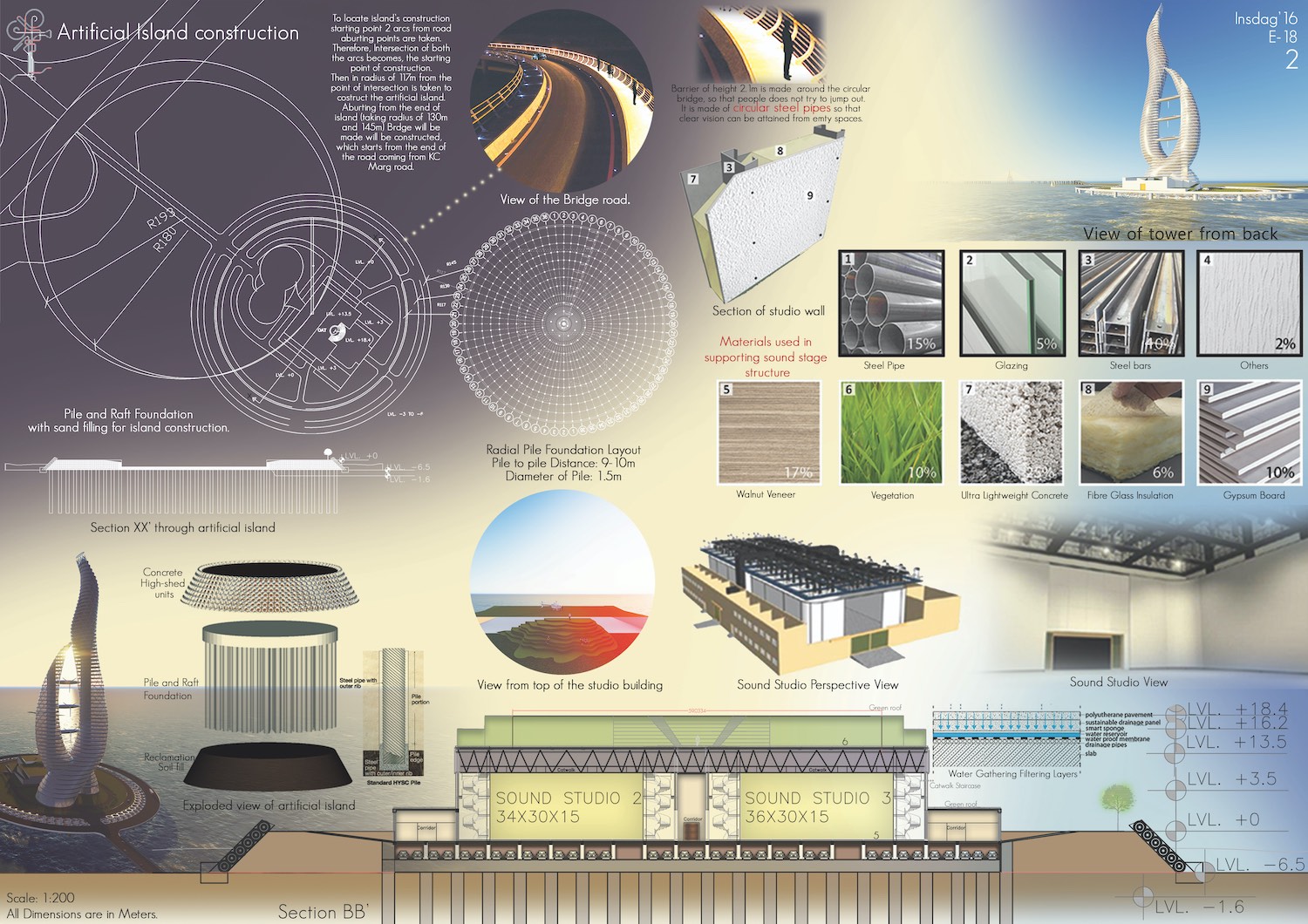
Limitations:
The big sound stages where set making is done and parking is provided in a ground floor structure at the back of the main tower which is covered with landscaping on the top. It is very difficult to transport huge sets and materials to such a height in a tower as extra machinery, lifts and carriers needs to be installed which can take huge amount of space in the tower interrupting other services in the tower.
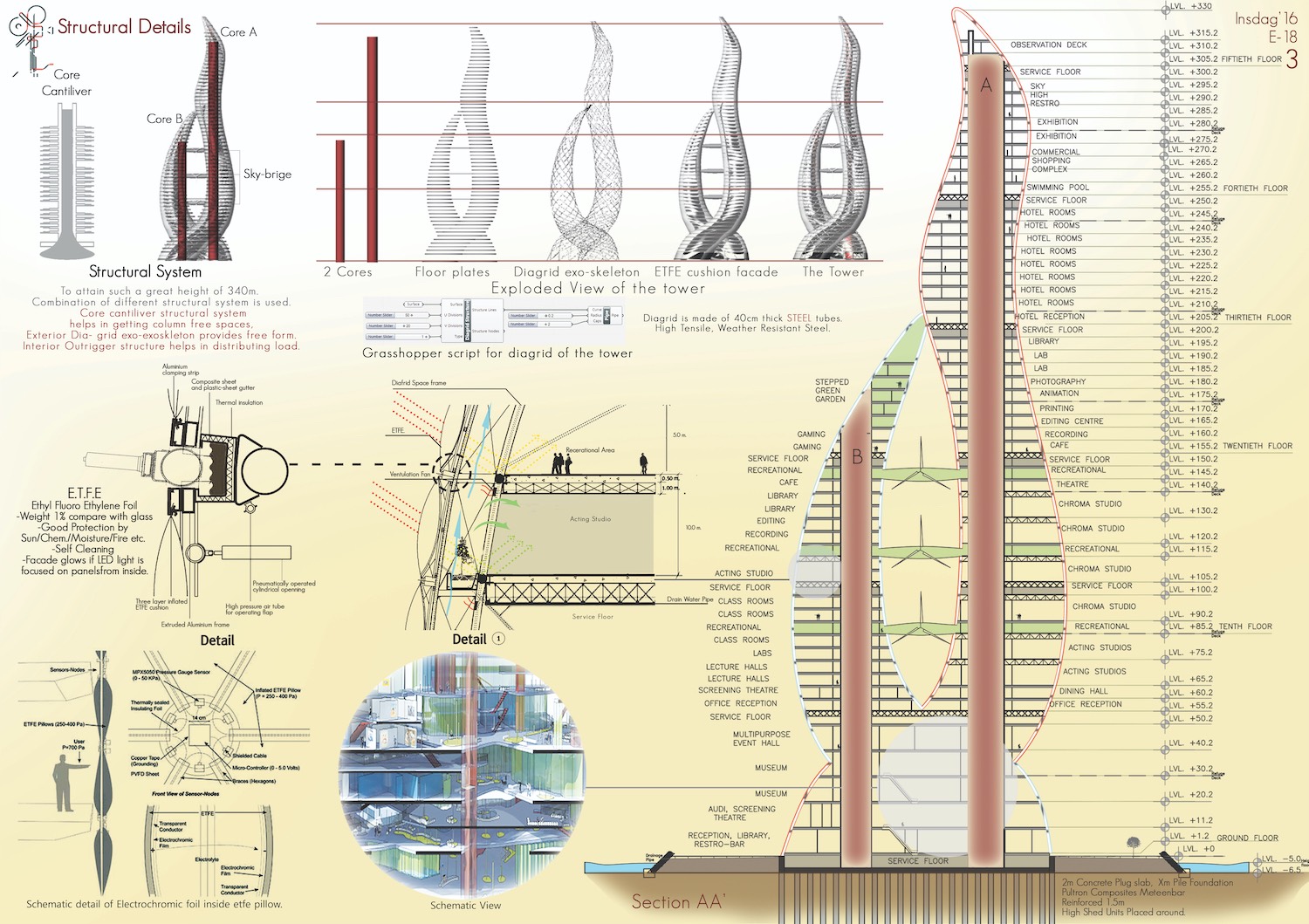
Areas of Research:
The Film City Tower aims to provide some necessary facilities that a fully functional film city requires. The tower has multiple land use, which can be categorized into commercial, recreational and public zones. The program includes a multitude of functions such as a Bollywood Museum, Production houses and a Film School which requires a segregated but unified approach to the program needs.
Hence, one of the major research topics would be the study of the process of film making and the various stages of producing a film. Secondly, the components of a film studio, spatial and technical details of various film studios and workshops. Another important research topic as per the challenges provided in the planning of a vertical typology involve the construction of a vertical structural system, island construction and sustainability in high-rise.
Areas of Research: Primary research: 2.1.1 PROCESS OF FILM MAKING
Secondary research: 2.1.2 PRODUCTION FACILITIES
Tertiary research: 2.1.3 STRUCTURE AND TECHNOLOGY
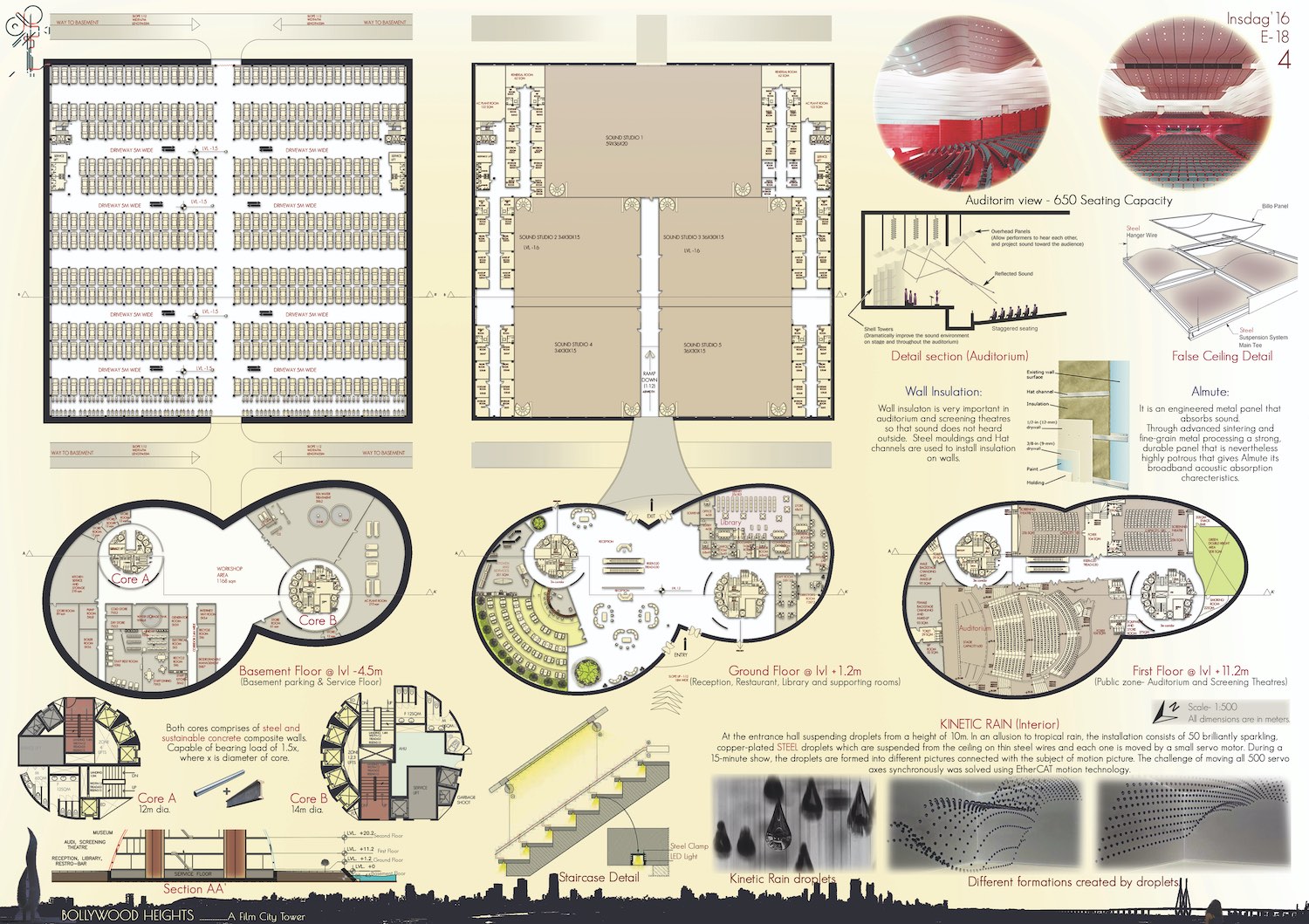
Case Studies:
1) Dadasaheb Phalke Chitranagri, Goregaon, Mumbai – Horizontally spread film city.
2) Whistling Woods International, Goregaon, Mumbai – Film Institute.
3) Atmosphere, Super-luxury Apartments, Kolkata – High-rise Residential Building
with miscellaneous activities.
Literature Studies:
1) Ramoji Film City, Hyderabad - Horizontally spread film city.
2) Film & television institute of india , pune– Film Institute
3) Burj- Al- Arab, Dubai – High-rise Hotel Building with miscellaneous activities
a. Basic functional requirements.
Site Analysis
Project: Bombay Heights, Film City Tower Location – Mumbai
Location: Mahim Bay, Mumbai
Site Area: 40,000 sqm
Maximum Ground Coverge: 12000 sqm.
The site is located at a distance of 100m off the BWSL promenade in the Mahim Bay waters, adjoining the Western Express highway.
Climate: Tropical wet and dry climate. Moderately hot with high level of humidity
Mean average temperature: 27.2 °C
Average precipitation: 242.2 cm (95.35 inches)
Maximum average temperatures: 32 °C (90 °F) in summer. 30 °C (86 °F) in winter
Minimum average temperatures: 25 °C (77 °F) in summer 20.5 °C (68.9 °F) in winter
WHY MUMBAI?
Mumbai is the largest metropolis of India. It is the financial capital and trade epicentre of the country, a city of lifestyles, cultures, traditions, religions, real-life-stories & narratives. Mumbai is renowned all over the globe for the enchantment of BOLLYWOOD, which is the nickname given to the Hindi Film Industry located in the city.
Why not any other city when mumbai already has a ‘film city’?
The neighbourhood of film city occupies prime land in the heart of Bombay, but has lacked the globalism and iconicity portrayed by the neighbourhood of Hollywood in Los Angeles, which houses all the legendary studios, theatres and film production units across its bay.
The cooler season from December to February is followed by the summer season from March to June. The period from June to about the end of September constitutes the south-west monsoon season, and October and November form the post-monsoon season. Temperature difference b/w surface & depth of 1000.
SWOT Analysis
The prime location of the site in the Mahim Bay is accessible through the KC Marg and is in a visual connection with West Bandra and the Bandra-Worli Sea-Link. The site is disconnected from the land and traffic and a dedicated entry allows for a secluded environment for the tower. The site demands a considerable amount of pedestrian access making it more accessible as an extension of the promenade.
The site needs a creation of artificial island and pile foundation to stabilize the skyscraper on sand. The services and other heavy vehicles must be transported to the artificial island which require proper road systems. The main connection with the city is only through vehicular and pedestrian connections which don’t provide a greater level of interaction.
The artificial island gives a scope for building without any restrictions pertaining to the adjacent buildings. The tower can be visualized in an exotic context with possibilities of providing viewpoints on all sides. The pedestrianization of the site can lead to a program which encourages public spaces on the lower levels of the tower.
The tower needs to be planned with respect to the sea wave activity and requires caution. The ever-increasing parking problem needs to be resolved both in the site and in the area allocated in the Reclamation zone, off the site.
OPERATIONAL ISSUES AND CHALLENGES OF A FILM CITY TOWER
Film studios often require complex management structures, but the objective should always be to keep the structure as strong and straight forward as possible. Two overriding questions should be addressed upfront in establishing a management plan when multiple ownership is considered. How will service be provided to various systems of the building? How can the detailed operating needs of each use be best served in the overall development and management plan? The major issues that are identified are as follows: Land Reclamation Efficient parking system without going underground. Separate entries to various types of people entering the film city. Column-free studios inside the tower. Refugee areas and service floors. Efficient core. Lift requirement and service circulation.
Material Palette
Mild Steel Rolled Sections including Beam Sections, Channel Sections and Angle
Sections etc.
Mild Steel Fabricated / Built-up Sections
Rectangular, Square & Circular Hollow Sections
Plates and Flats, Rounds and Squares
Wire Ropes, Steel Pipes
Corrugated /Plain/ Embossed Profiled Sheet
Colour Coated/ Plastic Coated/Galvanized Sheet
Stainless Steel Sheet and Sections
High Tensile Steel, Weather Resistant Steel etc.
Etfe Panels, Glazing glass.
Walnut Vineer, Vegetation,
Ultra lightweight concrete, Fibre glass insulation, Gypsum Board
Brief Design Concept
Bollywood Film City Tower is a conceptual design idea exploring a completely new vertical typology for film studios that have been traditionally planned over large sites. The site proposed is an artificial island of 4 hectares in Mahim Bay, Mumbai, the hometown of Bollywood, where land scarcity, land reclamation and high-rise buildings are common place. The iconic aspect of the tower is its shape like a trophy, gigantic proportion which metaphorically stands for inspiration to the filmmakers. It also represents glory, a flame and the shape like trophy itself represents the concept of ‘muse’. The facade is also supported with a diagrid along with ETFE panels. The program developed after the case studies of both film studios and high rise buildings incorporates a film school and public Bollywood museum alongside film production making it a mixed typology. The ground cover is 1.1 hectares (30.5%) which is majorly used for service areas. The flyover reaching the site is redesigned and separate entries have been accommodated based on the visitors who are later segregated. The site consists of two structures one is the Tower itself and the other one consists of 5 huge sound studios with basement parking. This structure is covered with green roof. Therefore, it doesn’t hamper the view of the tower. Whereas, the main tower is divided into 5 major zones: Public areas are in the lower floors, the film institute is in ‘B’ wing of the building and ‘A’ wing consists of production, post- production, leisure and miscellaneous and recreational areas. The concept itself is working with so many constraints which have shaped the function and form of the building with a whopping built-up area of 10 hectares. The building is designed in such a way that it generates its own energy for its use and thus, becomes a net zero energy building. It is 330m high tower with 3 huge wind turbines on three different nodes, to harness electricity. The service floors, refuge areas and other programmatic requirements are duly addressed to make the building as functional as possible. The skyscraper aims to create space for enthusiastic film makers to explore filmmaking and learning just like any other film city while the form creates an icon for Bollywood.
Project name: Bollywood Heights, A Film City Tower
Architecture firm: Vaishaly , Doodle Studio
Location: Mahim Bay, Mumbai , India
Project Status: Not Built
Year: Designed in 2016
By Naser Nader Ibrahim
Leave a comment
Related articles

Dancing Towers in Dubai, UAE by DNA Barcelona Architects
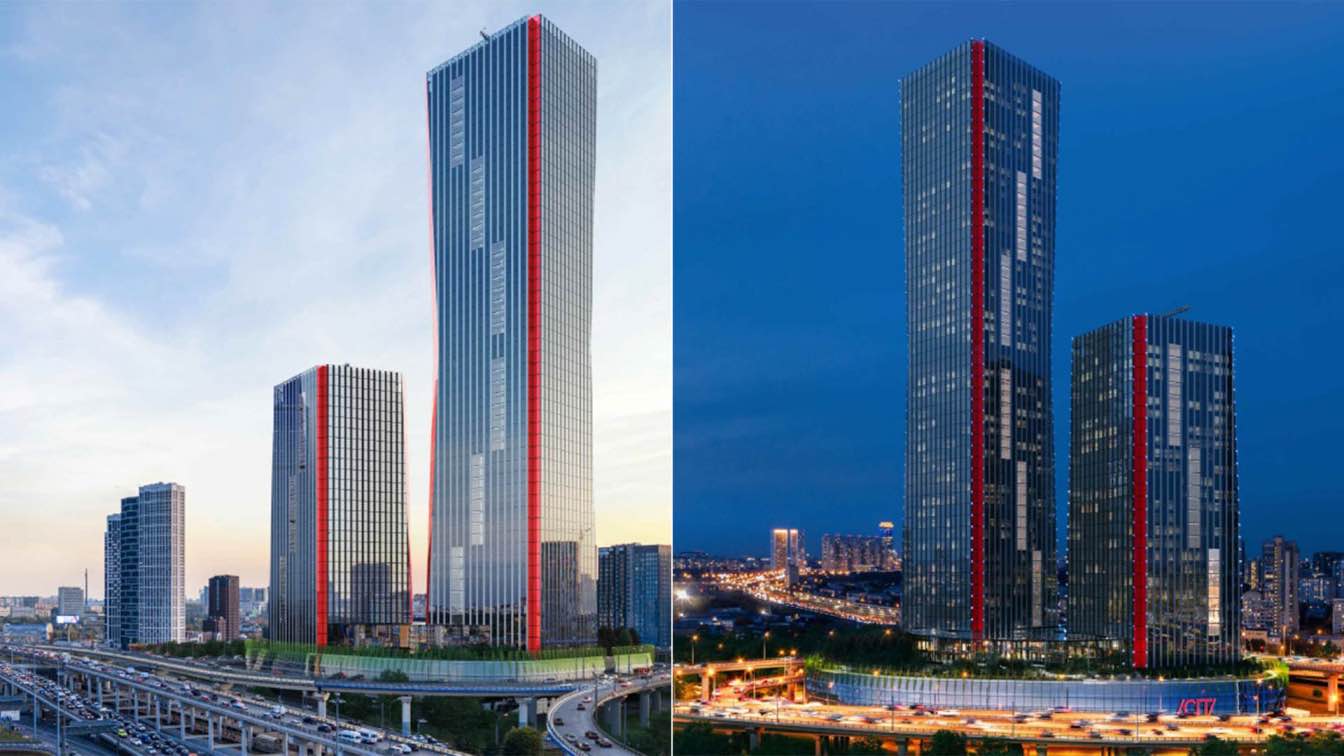
iCity: the new Moscow high-tech complex of two skyscrapers designed by CPU PRIDE and Helmut Jahn architects

Aedas wins first place in the Jing Brand (Wuhan) Real Estate Project Design Competition

Introducing Aedas-designed Zhanjiang Yunhai No.1

- Hand-Illustrated Explainer Videos
- Illustrated Conversation
- Infographics
- Strategy & Ideas
- Training Design & Development
- Event Communications
- Video Production
- Scripting & Script Assistance
- llustration
- Our Method: Scribology
- Our Process
- Our Guarantee
- What We Care About
- General Contact Info
- Book a Consult
- Book a Quote
- Schedule an Artist
Adapting to Change: The Cinema Case Study
Andrew Herkert
July 19th, 2022
Content Trends , Creativity in Business , External Communications , Products and Services

I recently had what might well be the single most modern cinematic moment of my life: I rented The Batman on YouTube, and watched it all three hours of it from my couch. Somewhere in the middle of it all, I realized how distracting and bizarre it was to be watching a blockbuster, of this length, through an online platform running through my television, and quickly encountered two (mostly) unrelated thoughts: I am getting old, and cinema is changing at lightspeed.
An Industry Already Under Siege
If I’ve used it once, I’ve used this Charlie Kaufman quote a million times: “Adaptation is a profound process.” Ask the biggest movie studios if they agree. As ticket sales have steadily sunk between 1995 and 2020 (and certainly not rebounded in the previous two years to any significant extent), one of cinema’s most important organs seemed to be on the brink of shutdown.
With an 82% collapse in 2020 in already abysmal ticket sales, the pandemic was poised to be the death blow to the American movie theater—and it almost was.
Pre-pandemic attempts to shore up theater attendance by hearkening back to the picture palaces of the 1930’s and 1940’s (when Americans commonly went to the movies twice a week) couldn’t keep compete with a lethal virus. Theaters were going to take another hit, this time with very little they could do but wait.
Sea Change upon Sea Change
Studios could work immediately to maintain viewership. Their reaction to the pandemic was to take even more steps away from dependence on the theater/box office model, and focus more on streaming services.
While bad news for theater proprietors, it made good sense for studios to take the approach. They still had to overcome at least one large obstacle, however—how do you charge movie theater prices for an experience that doesn’t happen in a movie theater?
Certainly part of that answer comes from trusting your consumer to understand that movies are not cheap, and that they must submit to some higher prices for a rental than they might in safer times. The other part of that answer had to come in the actual writing and production of the films offered.
Here, we see that cinematic content’s evolution began long before the pandemic became a dominant issue. Marvel movies, of pre-and-mid-pandemic years, have been basically unstoppable since 2008, and they’re a great collective case study for the modern, theater-crisis-aware film.
Familiarity Brings Comfort
What are Marvel movies, at their core? I’d argue three things, simply put: familiar, effects-heavy, and long. The common thread between all of these characteristics? Value, by specific metrics. Let’s examine this value assessment in a little more detail.
Familiarity is a definite sign of value. Brand identity exists for a reason, as do genres of film; they provide expectations to consumers. Audiences know Captain America, as he’s been in popular culture since 1941. They know what they’re getting from a movie that features him, and they know what they’re not getting. Captain America is low-risk, and intended for all ages.
Effects Show Value
I probably don’t need to convince you that Marvel is effects-heavy. I will, however, try to convince you that this is an outward-facing value indicator. In short, it’s proof of financial effort. Effects are one of the easiest places to see a film’s budget reflected. Dated as this reference may be, it’s not My Dinner with Andre that you’re paying $25 to rent while the film would normally be in theaters. It’s The Batman , with special effects that justify the price of admission the second you see them.
Runtime Justifies Costs
I’ll keep The Batman as my example for my last point: the value added through length. Some people hate long films, to be sure, but to many (arguably, many more ), length is an indicator of bang for one’s buck. It’s a hard sell to pay $25 to rent/stream a 75-minute movie. This is not the case with The Batman , at just shy of three hours.
Theaters might still be in a dark place, but as the pandemic starts to lessen its grip on the US, it’s entirely possible that its efforts to recall the golden age of theater-going might have success going forward. Studios, for their part, are working a value proposal that’s still young, but at least partly successful in maintaining audience viewership.
Evolution (However Halting)
It’s worth noting one final (coincidentally also Marvel) development in the modern cinematic landscape: the Johansson v. Disney lawsuit of 2021. Substantively focused on Disney’s alleged breach of contract with the actor over theatrical vs. streaming rights to Black Widow , the highly-publicized suit was eventually resolved amicably before 2021 ended.
That doesn’t mean it didn’t matter. CNN called it “ a flashpoint in an evolving Hollywood ,” and wrote that it “came at a pivotal moment as the industry faces questions about how audiences will consume entertainment in the future.” It’s proof positive that these questions are far from resolved.
It’s also proof of something more far-reaching: no matter the industry, your offering needs to fit the moment. When the market shifts, the correct response is rarely to dig in your heels. Instead, it’s time to evolve.
Cinema has changed distribution, content, and form to survive recent upsets in the market. The case study matters because the movies seem future-proof. After over 100 years of dominance, we can’t imagine a world without them.
Universal Issues
The lesson is that no industry is future-proof, and when threatened, all industries have to change pace, quickly. And if an industry as time-tested as cinema has seemed lost—numerous times—in recent years, other industries without such deep cultural roots will almost certainly go through as much change, if not more.
Supply chain issues are not just occurring in the places we’d expect. The great resignation has affected more sectors than we imagined. So, as these and many, many other issues assail your business, remember that it’s not your fault.
Control what you can control, and adapt. If it happened to movies, it can happen to anyone; fortunately, movies have shown the attitude necessary to survive even the most threatening changes.
Blog: Tagged Case Studies
Programs Fri 4.8.2022
SLOAN SUMMIT CASE STUDY: Coded Bias
by Matt Warren
Programs Thu 4.7.2022
SLOAN SUMMIT CASE STUDY: Tesla
Programs Wed 4.6.2022
SLOAN SUMMIT CASE STUDY: Adventures of a Mathematician
Programs Thu 6.18.2020
CASE STUDY: The Making of ‘Green is Gold’
by Film Independent
Programs Thu 6.4.2020
CASE STUDY: The Making of ‘K-Town‘92’
Programs Thu 5.21.2020
CASE STUDY: The Making of ‘Casting JonBenet’
Programs Thu 5.7.2020
CASE STUDY: The Making of ‘Political Animals’
Programs Tue 4.21.2020
CASE STUDY: The Making of ‘Brown Girls’
Programs Wed 4.8.2020
CASE STUDY: The Making of ‘Chasing Coral’
Programs Wed 3.25.2020

CASE STUDY: The Making of ‘Southside With You’
Programs Thu 3.12.2020
Case Study: The Making of ‘City of Ghosts’
Programs Thu 2.27.2020
CASE STUDY: ALGOUS STUDIO
customer story user case
A big interview with ALGOUS studio! CEO Alexei Gusev talks about Russian cinema, the film “T-34”, the future of the industry and off-screen difficulties of production and post-production.
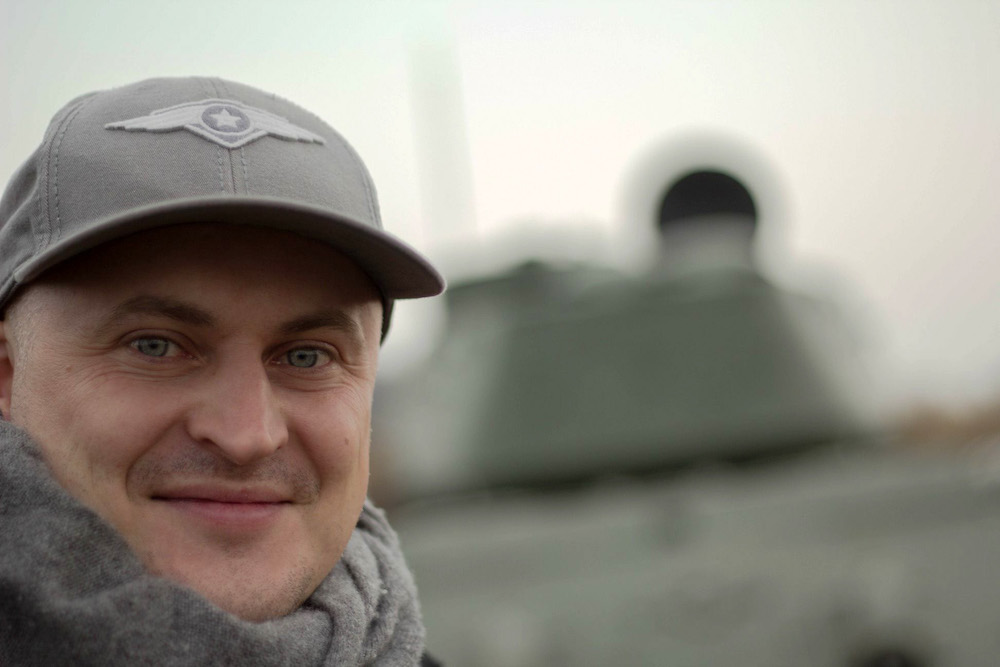
So, tell me how you started out.
It all started at the university, when I accidentally got my hands on a floppy disk with a program called 3D Studio. I was studying to be a systems analyst — a rather unromantic profession. I saw myself as a programmer, an engineer of various computer networks and systems, and certainly didn’t think there would be any graphics in my future. I borrowed this program just to take a look at it. They said that it was used to make graphics and advertising for the whole world.
When I installed it on my 386th computer, I immediately became interested in graphics, and by the time I graduated from the university, I was already doing something in this program myself. Then I got a job on television in St. Petersburg, on Channel 51, I think. I was using computer graphics to make funny programs and ad breaks. It was all very naive and looked nowhere near decent, but it was a start that fueled my interest in graphics.
Later, I found myself at Lesta Studio. It still exists as part of Wargaming, a company that makes games about ships and all that. At that time, the studio specialized in advertising and video production for television. That was the moment when real graphics lessons began. I studied Maya and other programs in which you could do something serious.
During that time, I also met Sergey Tsyptsyn. We met in Moscow at Maya User Meetings, or MUMs. I started going to these meetings in Moscow almost every month to give presentations. There were no courses at that time, except for the school where Tsyptsyn taught. I was studying Maya by myself and would often adopt some methods on the go, so we had experience working with Maya which I shared at these seminars. Thus began our journey of mastering high-level visual effects software skills and tricks.
Anyone who works in advertising or makes videos has a dream of getting into the film industry. I had to wait several years for my chance. I worked in advertising for three or four years. Then, in 2000, I received an offer to come to a film set to help create things that were not suitable for live-action filming. They were shooting a TV show called Spetsnaz, which would later become very famous. They still rerun it every year. The cast consisted of major Channel One, movie, and TV show stars.
After that, I decided to leave Lesta Studio and started working at SVAROG FILMS, which offered me to form a visual effects department. I got the first three or four people on my team in 2001. We started going to film sets and making rather bold visual effects that almost no one used in TV shows back then. In 2006, our team decided to set up its own company called Algus Studio.
This was almost 13 years ago. Next year will mark my 20th year in the film industry and 21st in computer graphics [laughs].

Do you remember the first objects you created?
I do! It was a chessboard. I wanted to put some balls on it and make them reflect light, refract it, cast shadows… It was very primitive, but I was amused by the possibilities of reflection and refraction: everything that wasn’t simple and required some tinkering. There was no ray tracing back then that would have allowed this to be done with a single press of a button. I had to come up with some tricks, but it was interesting.
Nobody worked in Maya at that time, apart from a few people. Everyone used Max, After Effects, and so on. This is why Sergey Tsyptsyn’s school was so popular. It provided knowledge that wasn’t available anywhere else. This is the reason our group still exists. We meet regularly in Moscow and don’t forget about each other. Those were the good times.
Are you talking about CG-Event?
All these user meetings have long evolved into CG-Event and other large events. But back then, it was a cozy get-together of computer enthusiasts from all over the country that took place in a single room. Not a global event at all. It was as authentic as it gets.
And now the atmosphere is gone?
Now everything is too serious, too global. The echoes of that atmosphere can only be felt at CG-Event afterparties, when computer industry proponents who still remember the old days gather together in small groups. There were teams that knew each other even before I came to Moscow, but I was around for the most interesting part.
So what is lacking now? Soul? Or were the people different back then?
No, everything is as it should be. Pioneers always have a special drive. And when almost every studio has access to modern technology, that drive disappears. Those who stood at the origins of our industry interacted with each other a little differently. Nowadays, almost every studio has access to various technologies, programs, and online courses. They have the opportunity to work abroad, gain experience, and come back here to share it, or stay there. Back then, we didn’t have the qualifications to go work in another country. Today, there are a lot of talented specialists in all areas. Unfortunately, this leads to high personnel turnover.
Do you see it in your segment?
Yes, constantly, because we level up anyone who comes to us. We offer a serious, powerful start for any artist, give them the opportunity to work on large and successful film projects. It is natural and inevitable that people want to go live in another country.
Is there a shortage of talents in the industry?
Yes, but everyone decides for themselves. As for me, I made my decision a long time ago. I always knew that I could also go and work abroad. But staying here and becoming one of the first people who could change something seemed better than being a cog in the wheel of an industry veteran. Here we have a chance to come up with something new, which is exactly what we’re doing.

How many people work in your company?
The number of people varies from project to project. There were 30 of us recently, but now this number has been reduced to a little over 20. We don’t see it as something bad. After all, the key to success is having a backbone, a powerful core. Some people come and go in order to keep growing. Not everyone is comfortable working in our industry: we have a rather unpredictable schedule of ups and downs. There can be tons of work, strict deadlines, and then suddenly almost no work at all. Not everyone is comfortable with such extremes. Many people prefer stability to aiming high and pushing themselves to the limit, like we wanted to 20 years ago. We didn’t care how much we worked. We could live in the office for weeks. We didn’t ask for any compensation, because we felt the drive and recognized that we were doing something very important.
Now everything is much more down-to-earth. People value comfort and working conditions more than goals or projects. I’m talking about ordinary artists, of course. For managers and supervisors a new project is always a challenge.
How do you deal with it?
Just barely [laughs]. Deadlines are met at the cost of pain and blood, projects become more and more difficult. We can rarely use something old, because technology and software are constantly changing. This leads to poor time management and force majeures. The industry is still young, and competent planning can be a problem. Film producers don’t always understand how much time is needed to make graphics, so they sometimes force us into rather difficult circumstances.
How do you solve these situations?
We improvise. Some projects are so good that when we see the rough cut, when we know who the director and producers are, we feel motivated by the product. People get second wind and motivation to work more and be more creative. Personal qualities of supervisors, producers, and directors also affect how motivated the artists are.
For example, we finished the movie T-34 with great difficulty. It was a very complex project with many unpredictable tasks, but when they finished filming and we saw the rough cut, we knew that the movie would be very good. It inspired everyone. We knew we had to give our best for a movie like that.
However, this didn’t save us from the deadline: the amount of CG required grew with each day. We had to change a lot of things in the process. The amount of unfinished work that had to be wrapped up before the movie’s release kept growing, so the last months were very intense for everyone. Our company also supervised seven other firms and many freelancers. It was difficult in every sense: logistically, creatively, and technologically. But we knew that the movie would be good, and it helped (laughs).
T-34 was a special project. You filmed inside a tank. Can you tell me more about why this project was unique? What life hacks did you use?
The most interesting decision was to shoot inside a real tank. Based on what we saw in foreign tank films, they were usually shot inside mock-ups, sets that were built for the operators’ convenience: light, cameras, freedom of movement. Filmmakers try to create the most comfortable working conditions for themselves. And a real tank is uncomfortable for both the film crew and the actors.
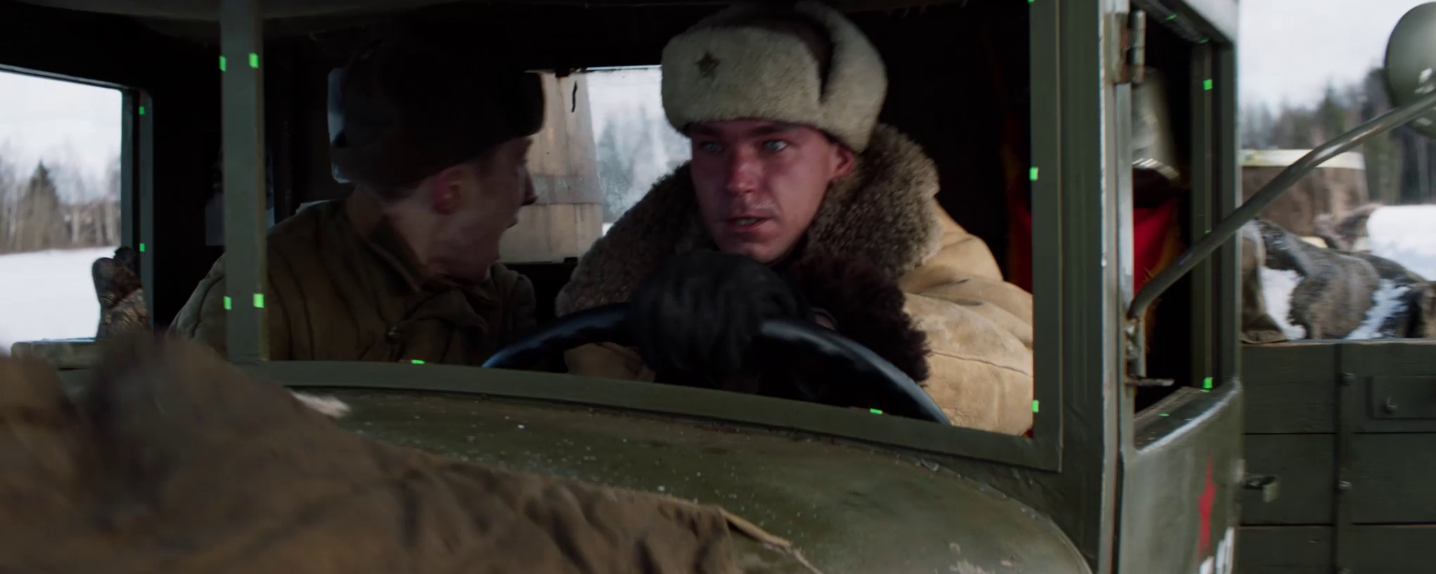
This is precisely what played the key role in our decision to shoot inside a real tank. Discomfort wasn’t bad, it made things more realistic. There was no danger of a real battle, but the actors could have a more natural experience. The tank was moving, they were controlling it themselves. There was no operator or director nearby, only five cameras. The tank was moving on rough terrain, so the actors were forced to shout over the roar of the engine. They would bang their heads against the walls during sharp turns, and they could barely hear commands on the walkie-talkie. It was pretty uncomfortable, but much more convincing than shooting in a cozy and warm studio.
When we saw this on site, we were amazed by how much different it felt from what we’ve seen before. The director was convinced this was the only way to shoot. Poor actors had to put up with it [laughs] and endure till the end. They had to spend 12 hours inside a tin can, in motion, in the cold. The atmosphere was jittery, because we had a tight filming schedule and needed to shoot a lot of material.
There were lots of nuances: for example, how the tank turned. The actor had to pull a specific lever, and everyone had to move in that direction, because according to the scenario, they were going left, not right. We couldn’t afford to be sloppy. Everything was done meticulously and painstakingly, as much as it was possible in a movie. That’s why the result was so convincing.
We also used a lot of other know-hows. Including the decision to use CG only for many scenes. We didn’t plan this in advance. We always hope to shoot as much live-action material as possible, we don’t use computer graphics just for the sake of using it. An experienced visual effects supervisor should strive to saturate a movie with visual effects it can’t exist without, not spend energy on things that would have looked more convincing as live action.
So at first we decided that we would shoot a lot of live action. However, in the process of filming we were faced with circumstances that made this impossible. For example, all the scenes where the tank is being pursued by an airplane across the meadows, fields, and roads… We realized that we just wouldn’t find the necessary landscapes, that we would never get permission to bring a real T-34 tank along with some German howitzers to the Czech Republic and shoot it all from a quadrocopter. Everything was so difficult to organize that I had to make a decision to make these scenes fully CG. It was a rather risky plan, because in Russia, no one had ever created so many complex environments and tank scenes with all the details and special effects convincingly enough. The director and producer understood that there was no other way and agreed with me, but we had to put our money where our mouth was [laughs]. We put a lot of effort into making the CG as convincing as possible.
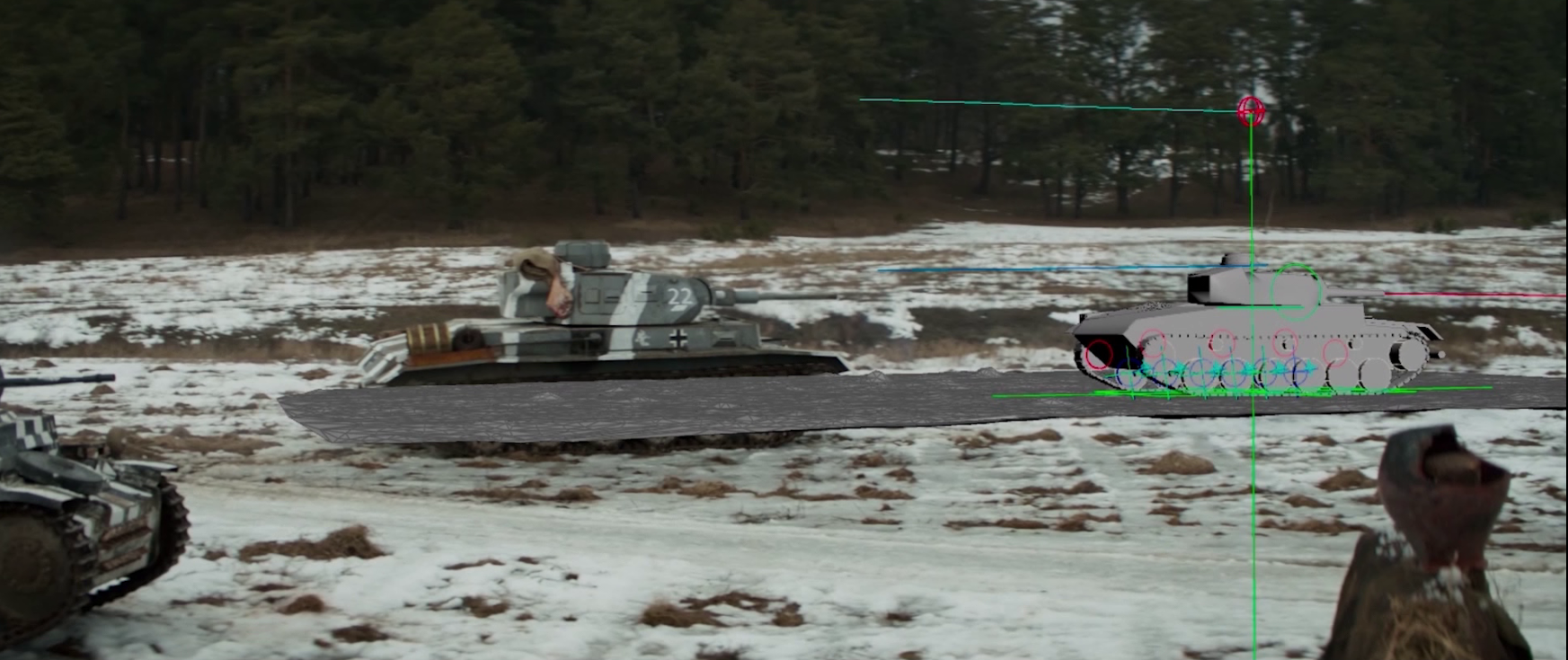
I can’t say that I’m absolutely satisfied with the result. You always want to do more and better, and always think that you need three or maybe two more months to make everything perfect and how you want it. So I am not 100% satisfied with our work. But this is inevitable. It has always been like that, and I hope it remains that way. I will never be completely satisfied [laughs].
The directors who work on such complex projects can also demand a certain level of perfectionism that you need to strive for, even if it seems irrational. If the director says so, you have to agree with him, sometimes reluctantly. Aleksey Sidorov turned out to be much more of a perfectionist than I expected, so we had to work hard to meet his ideas of what needed to be done in T-34 and how. So I think that he, just like me, also wasn’t satisfied with some of the things we had to consider ready when we actually would have preferred to work on them for a few more weeks.
As far as I know, you used slow motion in that movie. What was the most technically demanding thing about it and how many shots did you make?
We made about 900 shots in total, and hundreds of Full CG. They were made by different studios, and we needed them to look more or less the same. This is a difficult task, despite the fact that 900 shots is not that much for a movie that relies entirely on the use of visual effects. But when we were preparing to shoot this movie, we weren’t planning to rely on computer graphics that much. We had a lot of complex shots that required R&D, long research process, and tests in order to achieve a result that would more or less satisfy the director. For example, the slow motion scene where a projectile flies into the tank and explodes into pieces, and its fragments should hit only certain characters. Such shots took more than two years to make: from the first tests, which involved penetrating tank armor with projectiles and splitting it into many different textures, and to the final version with all the nuances and actors.
In total we had about 15–20 slow motion shots. They turned out to be very different. Some took place outside and had only one geographical focus, for example, showing how expertly our heroes shot at each other through the house windows. Others were devoted to demonstrating something no one had ever seen before, like what happens when a projectile enters a tank.
Of course, one could say that slow motion was invented a long time ago. While this is true, it was invented mostly for entertainment purposes and for moving from one space to another, not for showing the horror and drama a tank crew experiences during battle. This is a completely different goal, even though it also involves an element of entertainment and the audience, for the most part, recognizes these shots as computer generated ones. They understand that it’s impossible to shoot something like that live. When we discussed this with the director, we decided right away to get ready for a wave of criticism regarding these shots after the film was released, because no one had ever seen something like this and it couldn’t be mistaken for live action.

We were ready for this and knew that our goal was not to entertain the viewer, but to show in detail how something like this happens and why in archive photographs we can see tanks with burned armor and towers that look like plasticine, and holes that look like a colander. People don’t think about how this happened and why the holes in the iron have such smooth edges. With these shots, were wanted to show the physics of this horror: the crazy speed, the huge bursts of energy, how everything is melting and you can’t hide from it, and how a single shot can kill the whole crew or miraculously spare them. There can be 20 holes in a tank, but everyone inside will be alive. There were such examples during the war. So no one can say that we lied. We checked the facts, did lots of research, involved endless consultants, and studied a lot of archive photographs. And we can say with confidence that we didn’t cross into the genre of fiction.
And there were projects where you crossed this line?
Yes. It happens with almost every project. More often than not, the main purpose of a movie is to entertain, not pursue some deep goals. That’s if we’re not talking about independent films. People usually just want to enjoy the movie, so directors and producers ignore the facts of life in order to please the viewer. They say, “We’re not filming a documentary, are we?” Everyone knows that you can embellish things a little, but in T-34, we stayed as real as we could: you can see discrepancies in the episodes only under a microscope.
When you work on large projects, you use the services of other studios. How do you manage to work with so many people involved in the process?
I think it’s because of my experience as a supervisor. When you’ve been working in the film industry and on sets for 20 years, you understand that certain decisions lead to certain results, and you can quite sensibly distribute a huge amount of work between different studios while maintaining an adequate budget.
The more you work, the more you can get involved with global projects. Because you already understand that a certain task requires two studios of a certain size, but only one studio in the country can do this difficult task, and they need to be booked in advance. The more you work, the more you can get involved with global projects. Because you already understand that a certain task requires two studios of a certain size, but only one studio in the country can do this difficult task, and they need to be booked in advance.
Knowledge of the market, friends in the industry, and supervisor experience allow me to accurately predict a movie’s budget and production time. This gives me the opportunity to competently manage the whole process, because I speak the same language as all the contractors and colleagues from other studios, and at the same time I can be a fairly reliable producer, an assistant who won’t spend the budget on nothing. Film producers don’t always understand the pricing in computer graphics. Few of them had close experience with CG, so they are easy to fool. To prevent this from happening, experienced people hire a visual effects producer who knows the market and can effectively allocate the film producer’s budget.
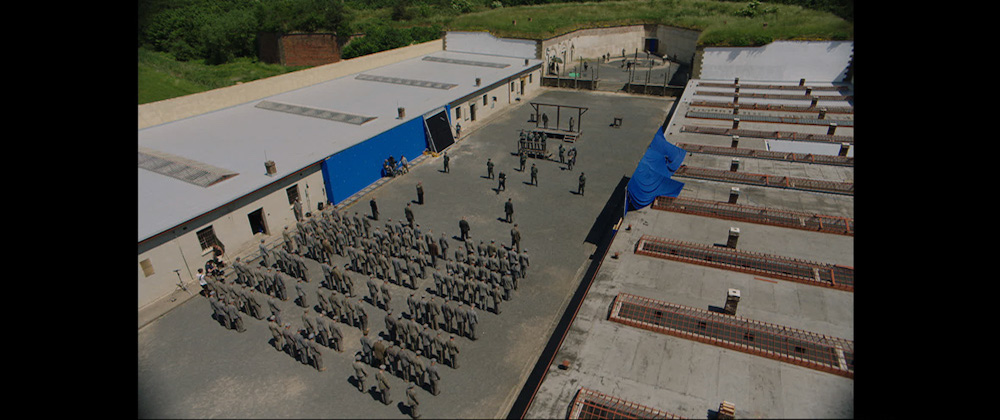
In the case of T-34, we have had a long working relationship with Aleksey Sidorov, and Ruben Dishdishyan also knew me well, so I was entrusted with being a visual effects producer and supervisor at the same time. They knew I would act in the interests of the movie and do everything to stick to the approved budget and produce the best possible result within that budget.
I would really like for the profession of a visual effects producer to take root in our country. It is currently a rare phenomenon. The film company usually hires a single studio, which then tries to work within the agreed budget and outsources something if it can’t. But when you know in advance there will be too much work for a single studio to handle, it’s better to hire not only a supervisor, but also a visual effects producer.
The reason is that this is a separate job. You have to find vendors and contractors for a huge amount of different work, reach an agreement with them, discuss the pipeline (that is, the production process): what programs will be used, how it all will be transferred, where it will be rendered. It is important that everything coincides, that money isn’t lost anywhere, and that one thing is not done several times. A visual effects producer should understand all this, and only then will all the money allocated for CG be spent truly efficiently.
For example, when I worked with Pasha Semerdzhyan on Salute 7, he solved a huge number of issues as a producer, it was very convenient and greatly facilitated my work as a supervisor. And when we were filming T-34, it was actually quite difficult for me to do these two jobs simultaneously. Two people inside me were constantly arguing with each other. One would say, “It’s cheaper here.” And the other would answer, “No, I can’t, the quality will be bad.” The first kept repeating, “Who cares about quality?” And the second one would say, “No, I can’t screw up.” That’s how I talked to myself at night instead of sleeping [laughs].
Do you spend a lot of time on site?
When I take on a project that relies heavily on the use of visual effects, I’m there all the time. This isn’t necessary in all films: a large amount of work can now be done without having a supervisor on site, because, thankfully, both cameramen and directors often understand CG and know what elements can be removed from the shot without calling the supervisor.
When we filmed T-34 and Salute 7, I was constantly on site. When we were working on T-34 from 23 February 2018 and until July 2018, that’s almost half a year, I was almost always near Moscow or in the Czech Republic. Every day we were faced with serious issues: how to show objects that are not there. That’s why I had to always be on site.
Do you like your work or are you already growing tired of it?
I only survive because I love this process [laughs]. I especially like the development process, the pre-production period when everything is only just starting and we haven’t yet encountered anything bad. We do animatics and storyboards and dream about how we will film everything and how cool it will be. This is the most romantic and wonderful period. Then the filming begins. It’s much more complicated and way less romantic: you need solid physical stamina. The filming is followed by post-vis, which is also a more or less creative period. At this time, the editing is not yet finished, and they need to make it final using our preliminary work. That’s when we can still come up with something, create animations, add something to the shot that didn’t turn out so well, and fix a few things. And then mass production begins, and there is nothing sentimental about it. It’s a pure race for survival. Now this is when it gets really hard and I start wishing I could switch to another project [laughs].
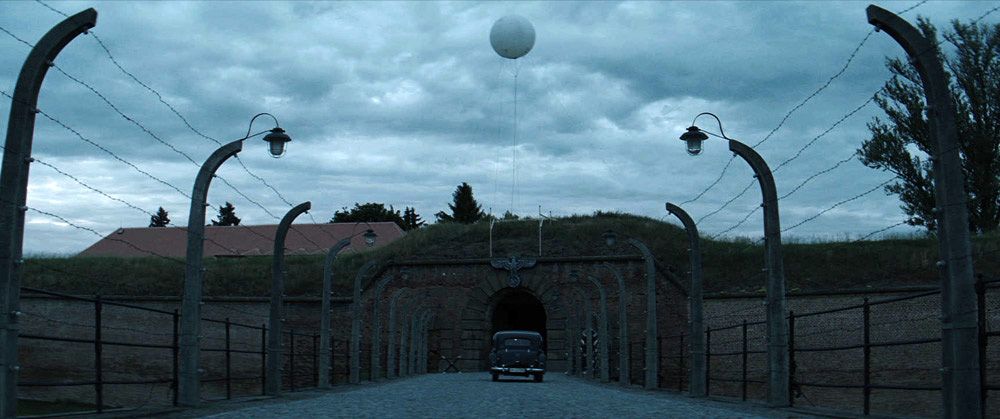
How often do you go on vacation with a schedule like that?
Last year, for the first time in my life, I went on vacation for a little over a month. I had never taken such long breaks before. It was always two weeks tops, during which I only had the time to exhale. I didn’t even have the time to catch up on sleep. And that time, I took a good chunk of winter and turned it into summer. This happened as we released a quite successful movie, and it was like a balm for my soul: it meant that I was right to go on vacation and that all that effort wasn’t in vain [laughs]. I’m grateful to everyone who took part in that project. We made a showreel and published our work.
Where do you get your inspiration? If you look for it at all.
Inspiration comes from doing something you love. It’s the only thing that helps us survive the deadlines, because we know that the difficult times will be over, and that they will be followed by a more creative and inspiring period. So we endure from one wave to another. No work can be equally pleasant in all aspects. Even creativity has its own routine moments: any musician has to learn the parts of his instruments, study a lot, learn things by heart, play, and wear down the skin on his fingers. All of it to be able to play freely and enjoy the process. Our profession is the same. You have to work hard.
Have you had any small but interesting projects that you rarely talk about?
Over the years, we helped make many different films. There are projects that get way less attention than they deserve. For example, three or four years ago, we made several shots for a simple movie called I Won’t Return, commissioned by Sergey Selyanov’s company, STV. It was a touching story about two girls who escaped from an orphanage. We didn’t work on the set, everything had already been filmed. They came to us for help during the post-production stage. I was at the premiere of this movie, and I really liked it. Movies like that are remembered with warmth. There should be more of them. What I mean is, not all our work should be about complex and expensive computer effects from which we make money. Part of what we do should always be about movies that you want to rewatch. And the more such movies there are, the more inspiration we get for routine things.
I also really liked working on Anyai Melikyan’s movies Mermaid and Star, the movie Mongol, Alexander Sokurov’s movies, Salute 7, and, of course, T-34. I’m grateful for the projects that make me feel like it wasn’t for nothing. As for the movies that don’t turn out so outstanding or warm, well… They become just a craft. There is nothing wrong with craft, it also has a place in this world.
What are your favorite movies?
My favorite movie is Forrest Gump. Surprisingly, it uses a lot of CG for which it even got an Oscar. At the same time, I don’t want to watch it too often so as not to get tired of it.
I also really like Mr. Nobody, and that’s a movie I’m ready to watch again and again. And every time I watch it, I discover something new that I haven’t noticed before. It combines outstanding directing and the work of many departments with great acting, camera work, and music. This movie is good no matter which way you look at it.
There are so many movies that I’d watch again and again. They are all unique in their own way, so I can’t really rank them. Although they don’t have the sophisticated technology of Forrest Gump and Mr. Nobody. These are almost all of Tarkovsky’s films, especially Stalker and Andrei Rublev, Daneliya’s Kin-dza-dza!, Tears Were Falling, and Mimino. They all resonate with me. And, of course, the works of Zakharov and Ryazanov… [laughs]
Do you try to save your time by not rewatching movies?
You know, there are so many movies I haven’t watched yet. It would be enough for a lifetime. I always try to fill the gaps and watch the films that I’ve missed. You could probably call me a “well-watched” person. I’ve seen almost everything from IMDb’s Top 250 list, including some Indian films. I watched them and I wasn’t disappointed. The Indians make touching, kind, wonderful films. As for rewatching something, I think you should do it either for the soul or for learning: for example, sharing the pleasure of watching a movie that I’ve already seen with my son.
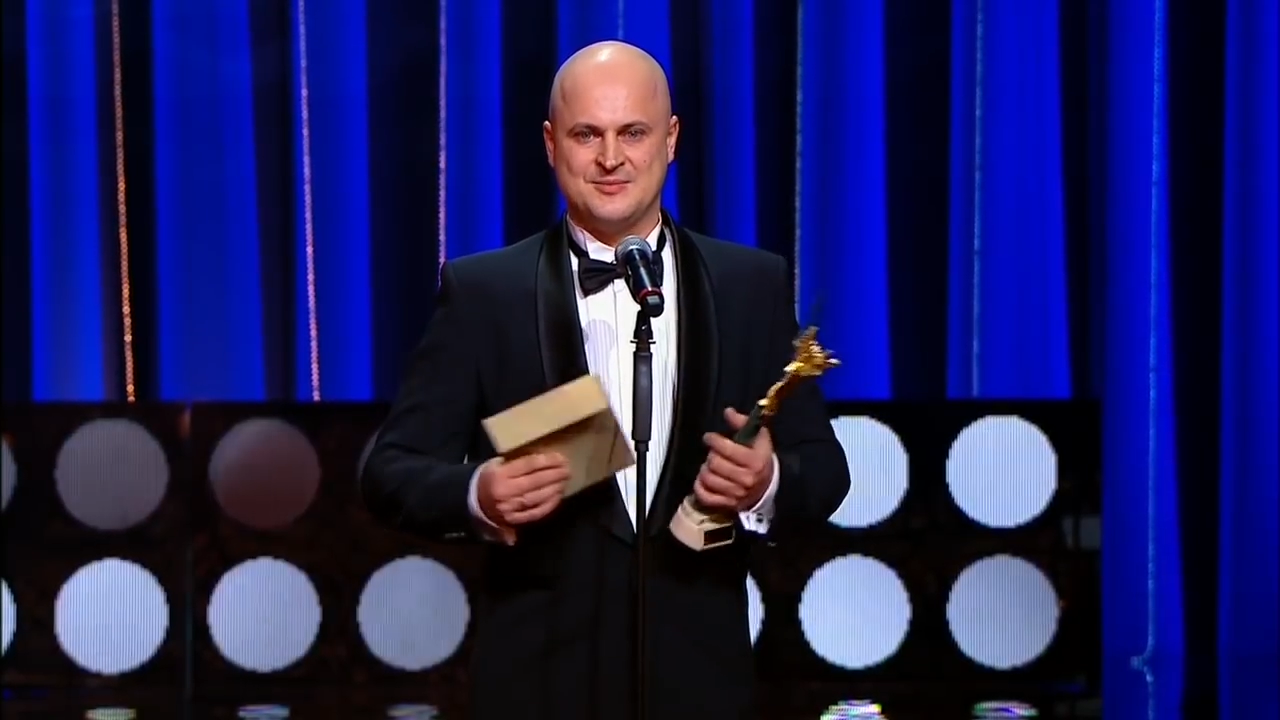
Do you have an Oscar yet?
With our profession, it’s hard to count on getting a foreign award. Our industry is still quite young. Russian movies received some prizes at all major international film festivals: Faust got the Venice Festival’s lions, Mongol was nominated for an Oscar. This suggests that, thank God, our movies are quite good. But in order for our work, specifically, to win an award abroad, the whole industry needs to grow.
In your Internet posts, you write that you are proud that the President of Russia has seen your movies, and that you would have something to share with him if you could have half an hour of his time. Care to elaborate?
I have a whole list, but if I could easily share it with the whole world, I would have done it a long time ago. The fact is, not all ideas can be brought to life without help. Of course, we must do what we can ourselves and not count on anyone else. That’s what I do and what I’ll keep doing. But I have a list of almost ten ideas, and each of these ideas requires a rather painstaking amount of effort. One or ever two of these ideas are quite outstanding and simply cannot be implemented without the support of the state and artistic institutions, such as museums and historical societies. This project simply can’t happen without them. Some things require you to either go all in or not do them at all. This is why I’m not making these ideas public. I don’t want to implement them with makeshift means. But I’m working on them. Polishing them. And I think there will come a time when the energies and needs of the outside world coincide with my wishes, and everything will work out.
About your wishes… Do you have any need for improvements to Cerebro? How often do you use it? Which features do you like, and which ones cause pain?
Mirada sometimes refuses to play files normally and can be terribly slow. Where other players can easily stream a video during rendering, Mirada dies, and this is very annoying.
There are also a couple of more subjective things. Some users think that Gantt charts can be used to plan projects and not just keep records of them, as Cerebro is primarily used right now. Cerebro could be turned into a more powerful tool. For example, if it was possible to watch the assembly cut of the episodes: not only shot by shot, but also several dailies combined into a cutting phrase.
I could name a lot of things that would be very useful to movie specialists, but absolutely useless for programmers or anyone else. To make a list of all suggestion for Cerebro, we need to write down everyone’s complaints and prioritize them by what is really painful, and what is more of a matter of taste.
In general, yes, we use Cerebro on a daily basis in all our projects. This is the only tool we use to streamline our work with different vendors and interactions inside the studio. We have created a bunch of different features that allow us to watch the shots during assembly, and to conveniently import and export projects from Cerebro: we generate Excel spreadsheets and then import them to Cerebro along with various tasks and subtasks. This is an automated process, and it would have been amazing if all of it could be done in Cerebro itself.
Many people also criticize Cerebro for the fact that there are other systems which make visual evaluation of the production process easier. Cerebro makes it quite difficult to operate big data and nodes: the resulting picture is not very informative.
When did you start using Cerebro?
It was a long time ago, as soon as it became easily available. We had no difficulties implementing it, except for some minor technical aspects.
Up to 50 users 50 GB cloud storage space Unlimited number of tasks No credit card required

Film Direction Case Study
[email protected] +14153490057 Support portal Cerebro Help Center Roadmap
[email protected] +14153490057 About Us Pay for licenses

Privacy Policy
Terms & Conditions
© Copyright Cerebro Inc. .
Academia.edu no longer supports Internet Explorer.
To browse Academia.edu and the wider internet faster and more securely, please take a few seconds to upgrade your browser .
Enter the email address you signed up with and we'll email you a reset link.
- We're Hiring!
- Help Center

EXAMINING FILM INDUSTRY SPACES IN HAWASSA CITY : PROBLEMS, PROSPECTS AND SOLUTIONS BSc THESIS PROJECT

2020, Paper for Bsc
The film industry is a big industry having its own major impact in the world and its economy. The film industry in Ethiopia and its regions is close to dead despite the potential the country has to offer and the benefits the country could get from it. Lots of reasons can be mentioned for this but the concentration of the existing film industry of the country being just in the capital despite major opportunities provided by other regions such as Hawassa city and lack of adequate purpose built film industry spaces can be considered the main ones. This thesis consists of researches and studies on the film industry and related activities in Hawassa city and proposed solutions based on the results.
Related Papers
Integrated Journal for Research in Arts and Humanities
Paulos Aemero
This study aimed at examining the current film festivals and filmmaking impact on the process of film company building process in Ethiopia. Thus, in this study qualitative research method was employed. Both primary and secondary sources of data were gathered where the primary data was collected through key informant interviews having 19 film maker participants of the film industry, Directors cinematographers including academicians in Ethiopian Universities in the field of film and Theatre Arts. The secondary date was obtained through books, articles and journals. The data was analyzed by using document and thematic analysis techniques. The study found out that limited or independent film festival preparation, frequent coping from western and European film festival ideas, ineffective film production systems, loose producers company unity, lack of government support on the national film festival, an increase in film festival conspiracy, the financial, human and material constraints, ...
Alessandro Jedlowski
Since the early 2000s, Ethiopia has witnessed the rapid growth of a local digital film industry whose economic model is similar to the one adopted by other industries of this kind emerged in African countries such as Nigeria, Ghana and Tanzania. Films are shot in digital format, are independently funded and commercially-driven, use Amharic as main language and target local and diasporic audiences. Unlike other productions of this kind around the continent, however, Ethiopian video films are firstly released in the large cinema theatres that characterize Addis Ababa’s urban landscape, and later circulate via VCDs, in Ethiopia, and in internet, throughout the diaspora. Within a context defined by a relatively tight governmental control on media production and circulation, the emergence of this phenomenon is introducing important transformations, and modifying the way locally-produced media are perceived and consumed within the Ethiopian public sphere. While being commercially oriented, in fact, videos do produce a social and moral commentary which portrays, and in some cases criticizes, the way the society has transformed over the past few years.
Journal of Cultural and Religious Studies
Aboneh Ashagrie
Even though Ethiopia marked a notable event in the history of world cinema by experiencing film viewing at the very early stage of the development of world cinematic art in 1897, the practice could not maintain sustainability due to various socio-economic and political factors. The pace in which the film industry was initiated was so crawling that it drastically lagged behind those countries that were exposed to the art years later after cinema was introduced in Ethiopia. Cinema in Ethiopia took almost a century to establish itself as a culture medium; but flourished late in the last decade as video formatted productions in Addis Ababa. The increase in number of film productions in the early years of the new millennium, together with the awareness created from the past experiences of American and European embassies and cultural centers that attempted to run film festivals annually in the city, seems to have motivated few interested-groups to organize local film festivals. Of all tho...
Black Camera
Steven Thomas
Michael W. Thomas , Alessandro Jedlowski , Aboneh Ashagrie
Over the past decade, Ethiopian films have come to dominate the screening schedules of the many cinemas in Ethiopia’s capital city of Addis Ababa as well as other urban centers. Despite undergoing an unprecedented surge in production and popularity in Ethiopia and in the diaspora, this phenomenon has been broadly overlooked by African film and media scholars and Ethiopianists alike. This collection of essays and interviews on cinema in Ethiopia represents the first work of its kind and establishes a broad foundation for furthering the scholarship. Taking an interdisciplinary approach to the topic and bringing together contributions from both Ethiopian and international scholars, the collection offers new and alternative narratives for the development of screen media in Africa. The book’s relevance reaches far beyond its specific locale of Ethiopia as contributions focus on a broad range of topics such as commercial and genre films, diaspora filmmaking, and the role of women in the film industry while simultaneously discussing multiple forms of screen media, from satellite TV to “video films.” Bringing both the historical and contemporary moments of cinema in Ethiopia into the critical frame offers alternative considerations for the already radically changing critical paradigm surrounding the understandings of African Cinema.
aboneh ashagrie
Michael W. Thomas
This study casts a socially orientated analysis of the impact of the cinematic space since the introduction of cinematic technologies to Ethiopia as early as 1889 E.C. (1986/7), during Menelik II’s reign. By presenting ethnographic research and comparisons of historical sources this paper offers new insights into the development of both the built cinematic space in urban Addis and the popular rural travelling cinemas of the Italian occupation (1936-41). After comparing early discourses positioning the cinema between modernising aristocrats and conservative clerics, the discussion then turns to the Italian occupation and the proliferation of both outdoor and indoor cinemas throughout Ethiopia. During this era, alternative discourses shall be highlighted; such as the Italian administration’s use of cinema as an instrument of subjugation and mass regimentation, and the subversive resistance perpetrated by Ethiopian spectators as they mocked projections of Italian prestige. After briefly mentioning the post war developments and the state monopolisation of cinema under the Derg regime, the paper discusses the commercialisation of cinema and the social ambivalences created by built cinematic spaces which populate present-day Addis Ababa. Older cinemas, located near Piassa and Merkato will be associated with አራዳ ‘Arada’ prototypes and seen as enclaves of social and moral ambiguities, mimicking the spatial and symbolic characteristics of their locales. Whilst Matti Multiplex, with its three screens and 7D simulator, is read as a translocal space in which the global desires of Ethiopia’s aspiring middle class and the high-end, expat appeal of Bole Road collide.
Minasie Gessesse
Journal of Development and Communication Studies
Mufunanji Magalasi
RELATED PAPERS
Papers on Philosophy, Psychology, Sociology and Pedagogy
Zora Raboteg-Saric
Michael Yukish
Desenvolvimento em Questão
Fernando A . P . Gimenez
Optics Express
Morten Andreas Geday
Jorge Ceballos
Lecture Notes in Computer Science
Juan Esteban Palacio Guarnizo
Revista Digital Internacional de Psicología y Ciencia Social
Evelin Gómez
JMIE (Journal of Madrasah Ibtidaiyah Education)
Jayanti Jayanti
Proceedings of 35th IEEE Conference on Decision and Control
Mattias Grundelius
Ecological Economics
Barbara Muraca
The Astrophysical Journal
Geoffrey Marcy
Journal of Industrial Economics
Ronald Fischer
Jurnal Transformasi Administrasi
suadi zainal
Marisa Dinis
Solomon Olaleye
Journal of Neuropathology and Experimental Neurology
Peggy Harris
Didactica Historica
Dominique Dirlewanger
JAD : Jurnal Riset Akuntansi & Keuangan Dewantara
International Journal of Telerehabilitation
Elizabeth Ward
Revista Facultad De Odontologia Universidad De Antioquia
DANIELA IVALU SANCHEZ LOPEZ
Journal of Mathematics Science and Computer Education
Muhammad Mahfuz
U-Sango ufike ngapham bi kukaRousseau (ZULU - SOUTH AFRICA VERSION)
(TIGRINYA VERSION ETHIOPIA ERITREA -EAST AFRICA) AFRO BRAZILIAN AND AMERINDIAN CULTURE
Estuarine Coastal and Shelf Science
Phillip Ford
OMICS: A Journal of Integrative Biology
Nyarai Soko
RELATED TOPICS
- We're Hiring!
- Help Center
- Find new research papers in:
- Health Sciences
- Earth Sciences
- Cognitive Science
- Mathematics
- Computer Science
- Academia ©2024
Pandemic Survival Strategy of Hindi Film Studios: The Case Study on Yash Raj Films
- Living reference work entry
- First Online: 09 November 2022
- Cite this living reference work entry

- Ipsita Barat 2
28 Accesses
In contemporary times conglomerates of the Hindi film industry such as Yash Raj Films, Disney UTV, Fox, Reliance Entertainment, Eros, Dharma Productions, Red Chillies Entertainment, and others are referred to as “studios” by the industry. One such prominent studio remains Yash Raj Films (YRF), a family-run private limited studio founded by Yash Raj Chopra in 1970 and run by his son Aditya Chopra. The company does film distribution in Indian as well as overseas markets. In addition, YRF also operates (as subsidiaries) through horizontal integration in allied entertainment industries like music, television, merchandising, digital, and comics.
According to the Federation of Indian Chambers of Commerce and Industry (FICCI) 2018 report, the value of the Indian Media and Entertainment Industry reached INR 1.67 trillion in the year 2018. However, COVID 19 pandemic struck this Hindi film industry in 2020 and stalled its growth. As per government regulation, multiplexes and single-screen cinema halls were shut down. As a result, film productions were also delayed for a considerable period. This paper will attempt to gauge how the film studios, for instance, YRF, survived and sustained during the pandemic. A collective understanding is that the industry survived with the aid of its alliance with over-the-top streaming (OTT) platforms such as Netflix, Prime, Hotstar, and so on. However, YRF had no OTT film released in 2020. Therefore, this research aims to understand how a studio like YRF survived during the pandemic times. The research will use an ethnographic method of qualitative interviews. This involves fieldwork and interviews with scriptwriters, producers, directors, actors, editors, cinematographers, production designers, and exhibitors. The interview and field visit will be an exploration of the business strategy of YRF, attempting to locate the methods and means of the survival strategy of the studio during pandemic times.
This is a preview of subscription content, log in via an institution to check access.
Access this chapter
Institutional subscriptions
Desai, J. (2004). Beyond Bollywood: The cultural politics of South Asian diasporic film . Routledge.
Book Google Scholar
Dudrah, R. (2006). Bollywood: Sociology goes to the movies . Sage Publications.
Google Scholar
Dudrah, R. (2012). Bollywood travels: Culture, diaspora, and border crossings in popular Hindi cinema . Routledge.
FICCI_ KPMG Indian Media and Entertainment Industry Report 2012. (2012). Digital dawn – The metamorphosis begins Indian media and entertainment industry . Retrieved October 19, 2016, www.in.kpmg.com/securedata/ficci /Reports/FICCI-KPMG_Report_2012.pdf
Ganti, T. (2004). Bollywood: A guidebook to popular Hindi cinema . Routledge.
Ganti, T. (2012). Producing Bollywood: Inside the contemporary Hindi film industry . Orient Black Swan.
IBEF. (2021). Media and entertainment industry report . Retrieved April 4, 2022, https://www.ibef.org/download/Media-and-Entertainment-May-2021.pdf
Inox Leisure Ltd. (2020, May 14). Statement by INOX on a Production House’s announcement to release their movie on an OTT platform by skipping the theatrical run [ Press Release].
Mishra, V. (2006). Bollywood cinema: A critical genealogy . Asian Studies Institute, Victoria University of Wellington.
Nelmes, J. (2012). Introduction to film studies . Routledge.
Prasad, M. (1998). Ideology of the Hindi film: A historical construction . Oxford University Press.
Prasad, M. (2003). This thing called Bollywood. Seminar 525 . Retrieved May 2, 2012, from, http://www.indiaseminar.com/2003/525/525%20madhava%20prasad.htm
Prasad, M. (2008). Surviving Bollywood. In A. P. Kavoori & A. Punathambekar (Eds.), Global Bollywood (pp. 41–45). New York University Press.
Punathambekar, A. (2013). From Bombay to Bollywood: The making of a global media industry . NYU Press.
Rajadhyaksha, A. (2003). The ‘Bollywoodization’ of the Indian cinema: Cultural nationalism in a global arena. Inter-Asia Cultural Studies, 4 (1), 25–39.
Article Google Scholar
Rajadhyaksha, A. (2008). The Bollywoodization of Indian cinema. In A. P. Kavoori & A. Punathambekar (Eds.), Global Bollywood (pp. 17–40). Oxford University Press.
Vasudevan, R. (2008). The meanings of Bollywood. Journals of Moving Image, 7 . Retrieved 2012, March 4 from http://jmionline.org/article/the_meanings_of_bollywood
Download references
Author information
Authors and affiliations.
Mass Communication & Videography Department, St. Xavier’s College (Autonomous), Kolkata, India
Ipsita Barat
You can also search for this author in PubMed Google Scholar
Corresponding author
Correspondence to Ipsita Barat .
Editor information
Editors and affiliations.
Centre for the Study of Law and Governance, Jawaharlal Nehru University, New Delhi, Delhi, India
Amita Singh
Section Editor information
NDRG (NAPSIPAG Disaster Research Group), New Delhi, India
Jaishri Jethwaney
Rights and permissions
Reprints and permissions
Copyright information
© 2022 Springer Nature Singapore Pte Ltd.
About this entry
Cite this entry.
Barat, I. (2022). Pandemic Survival Strategy of Hindi Film Studios: The Case Study on Yash Raj Films. In: Singh, A. (eds) International Handbook of Disaster Research. Springer, Singapore. https://doi.org/10.1007/978-981-16-8800-3_95-1
Download citation
DOI : https://doi.org/10.1007/978-981-16-8800-3_95-1
Received : 11 July 2022
Accepted : 29 July 2022
Published : 09 November 2022
Publisher Name : Springer, Singapore
Print ISBN : 978-981-16-8800-3
Online ISBN : 978-981-16-8800-3
eBook Packages : Springer Reference Business and Management Reference Module Humanities and Social Sciences Reference Module Business, Economics and Social Sciences
- Publish with us
Policies and ethics
- Find a journal
- Track your research
Subnavigation
- distri pedia ™ home
- ResourcePlace ™
- Digital Distribution Guide
- Case Studies
- Distributor ReportCard™
- :20 in ’22
- > distri pedia ™ > Case Studies
INTRODUCTION How to Read a Film Case Study in the New Normal
Available and forthcoming case studies*:.
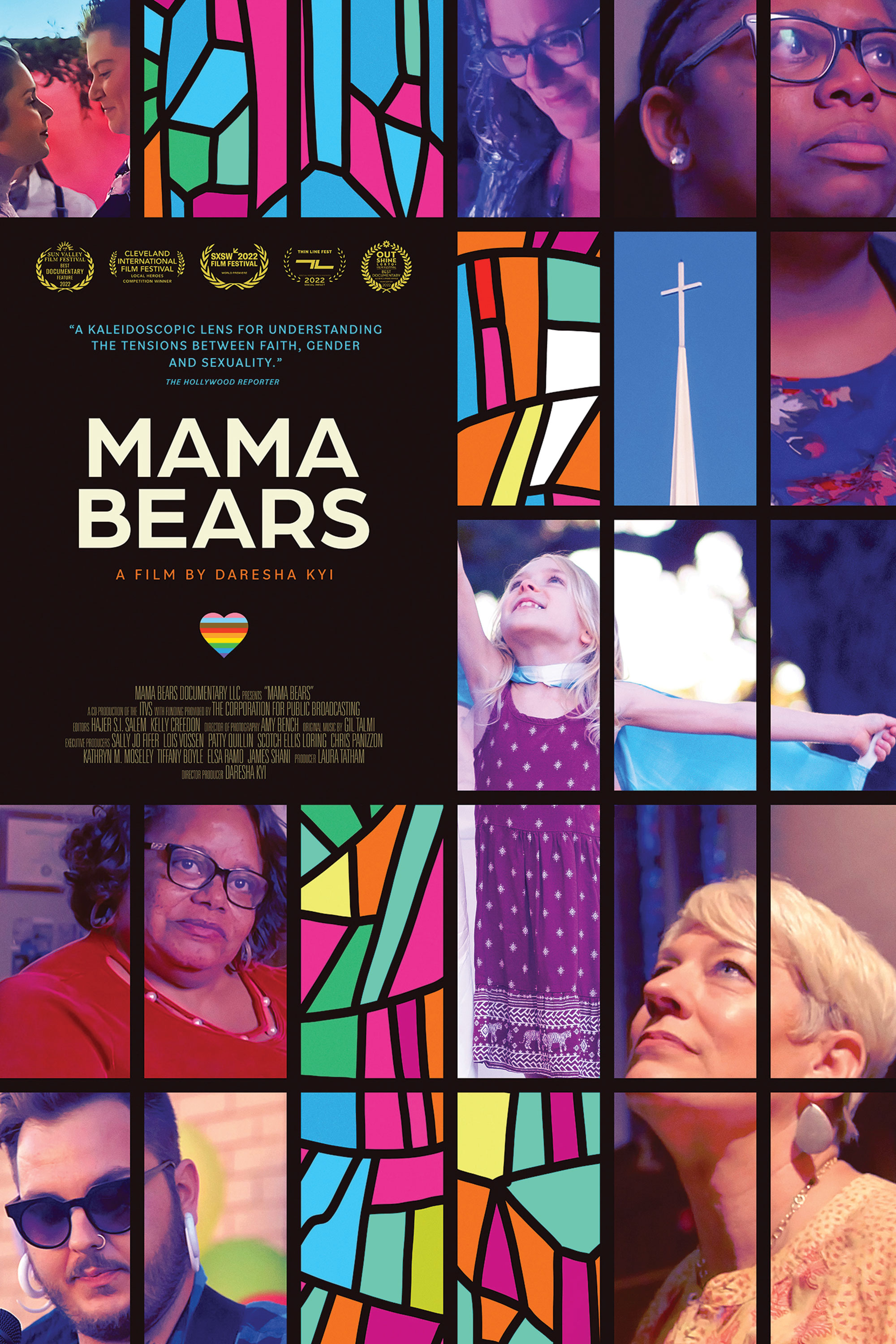
Director: Daresha Kyi
Festival Premiere: SXSW (2022)
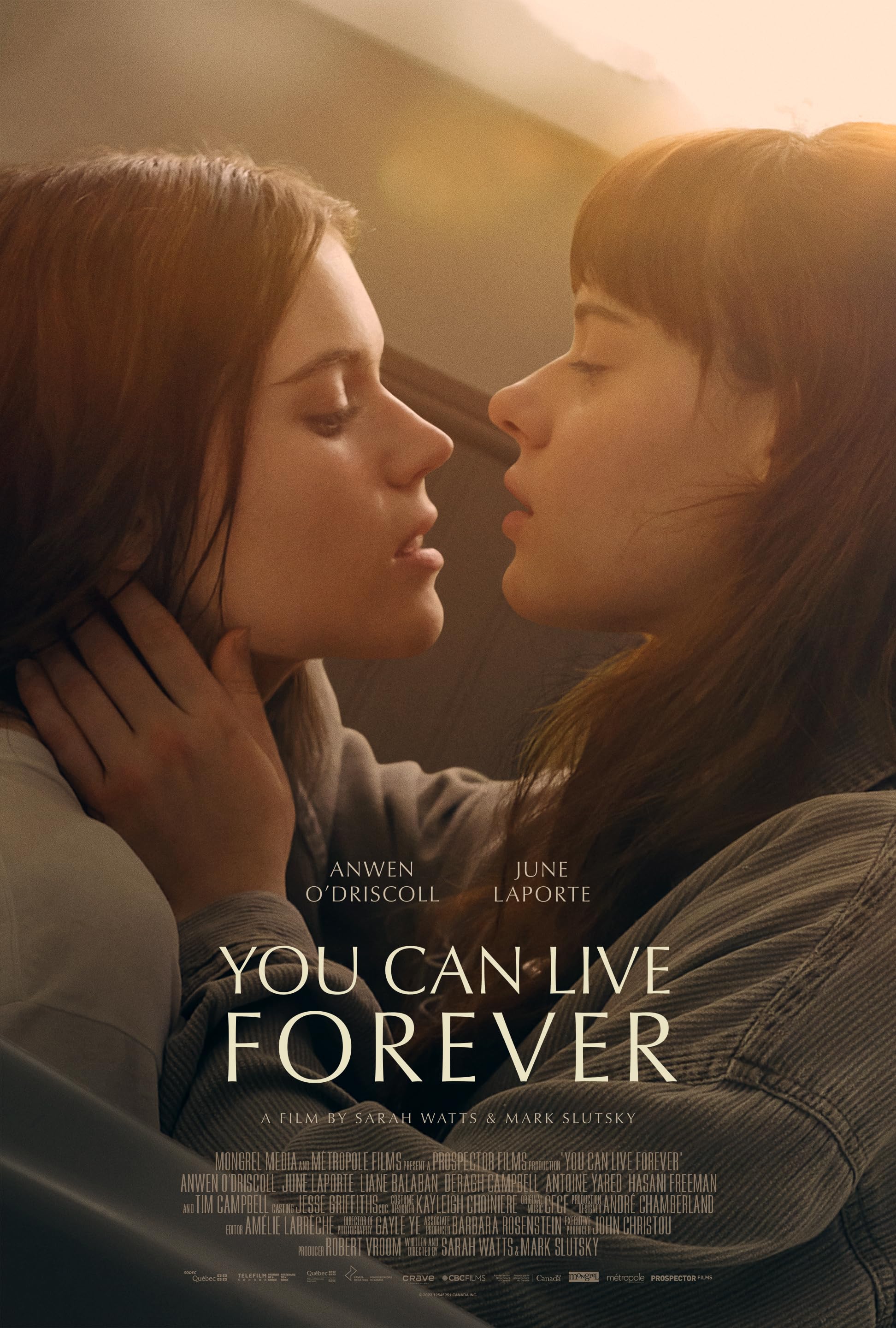
You Can Live Forever
Directors: Sarah Watts & Mark Slutsky
Festival Premiere: Tribeca Festival (2022)
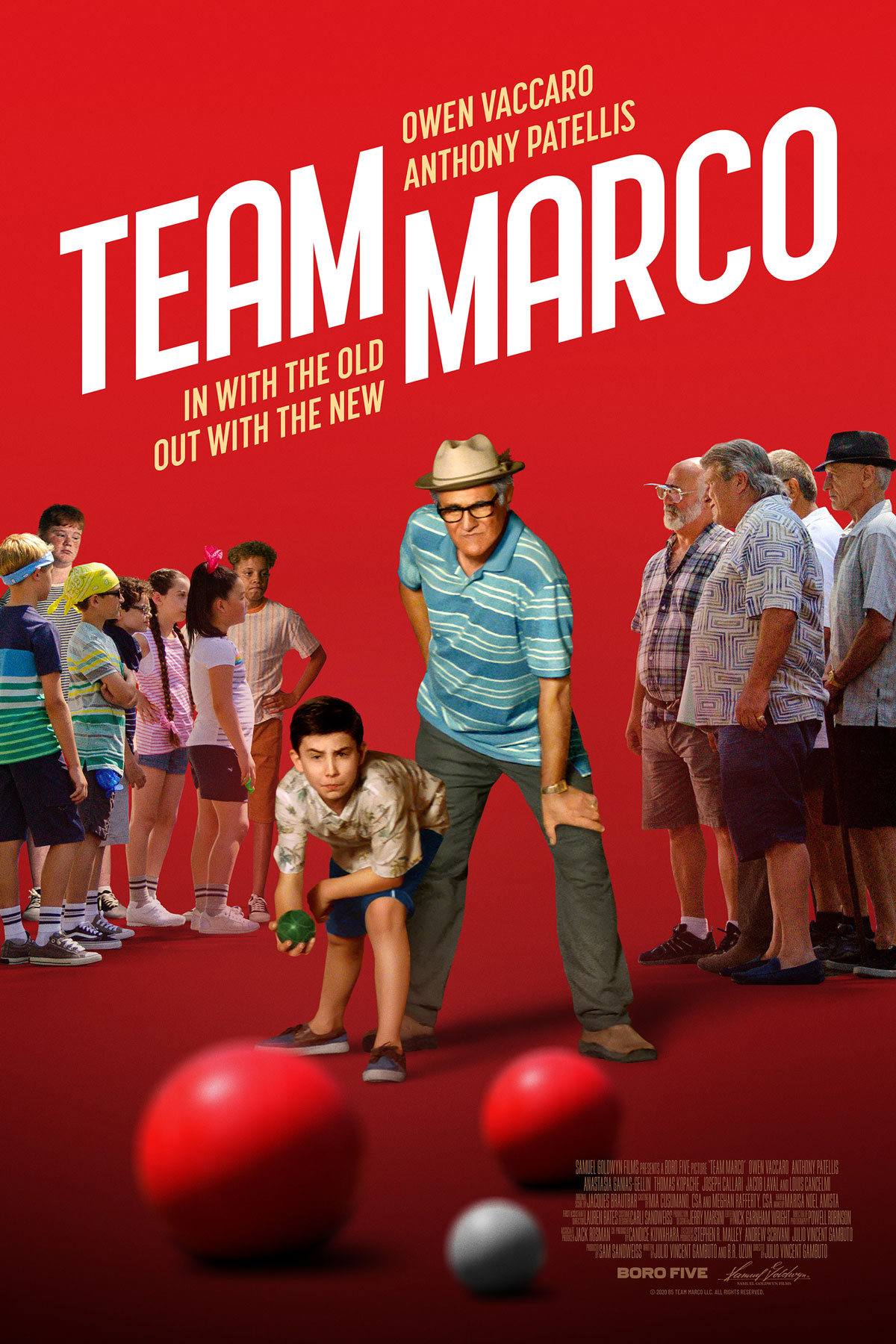
Director: Julio Vincent Gambuto
Festival Premiere: Mill Valley Film Festival (2019)
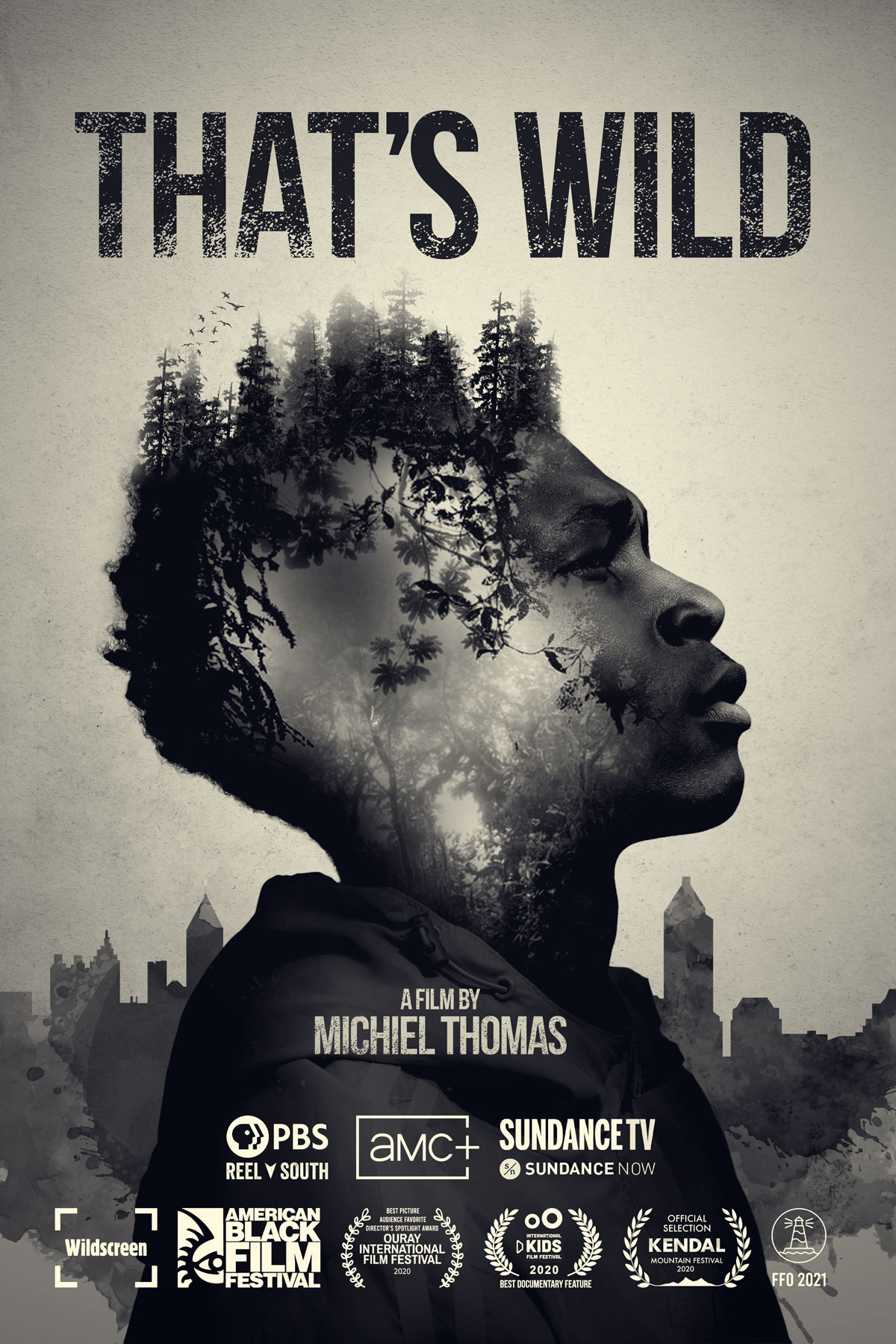
That’s Wild
Director: Michiel Thomas
Festival Premiere: Florida Film Festival (2020)
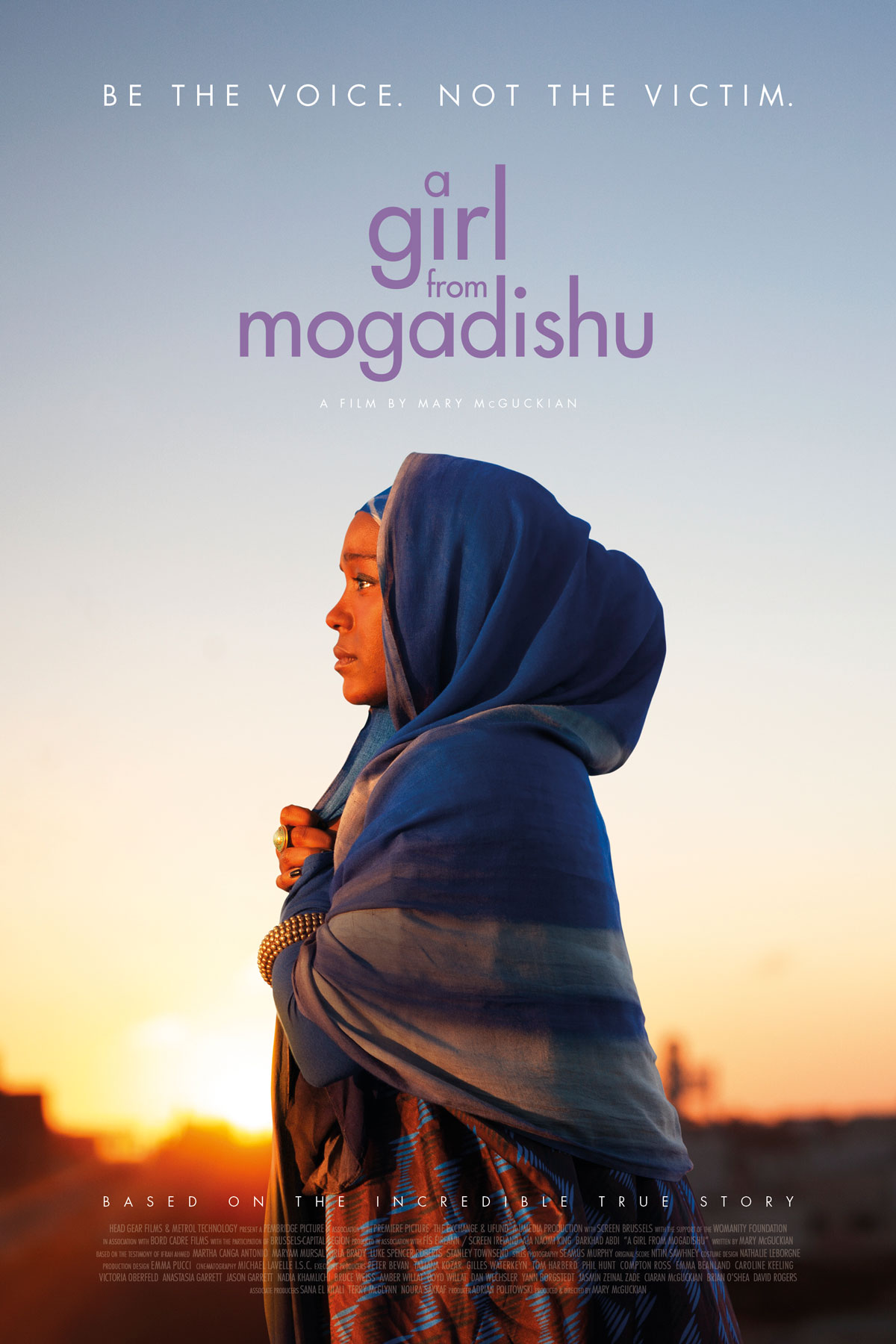
A Girl From Mogadishu
Director: Mary McGuckian
Festival Premiere: Edinburgh International (2019)
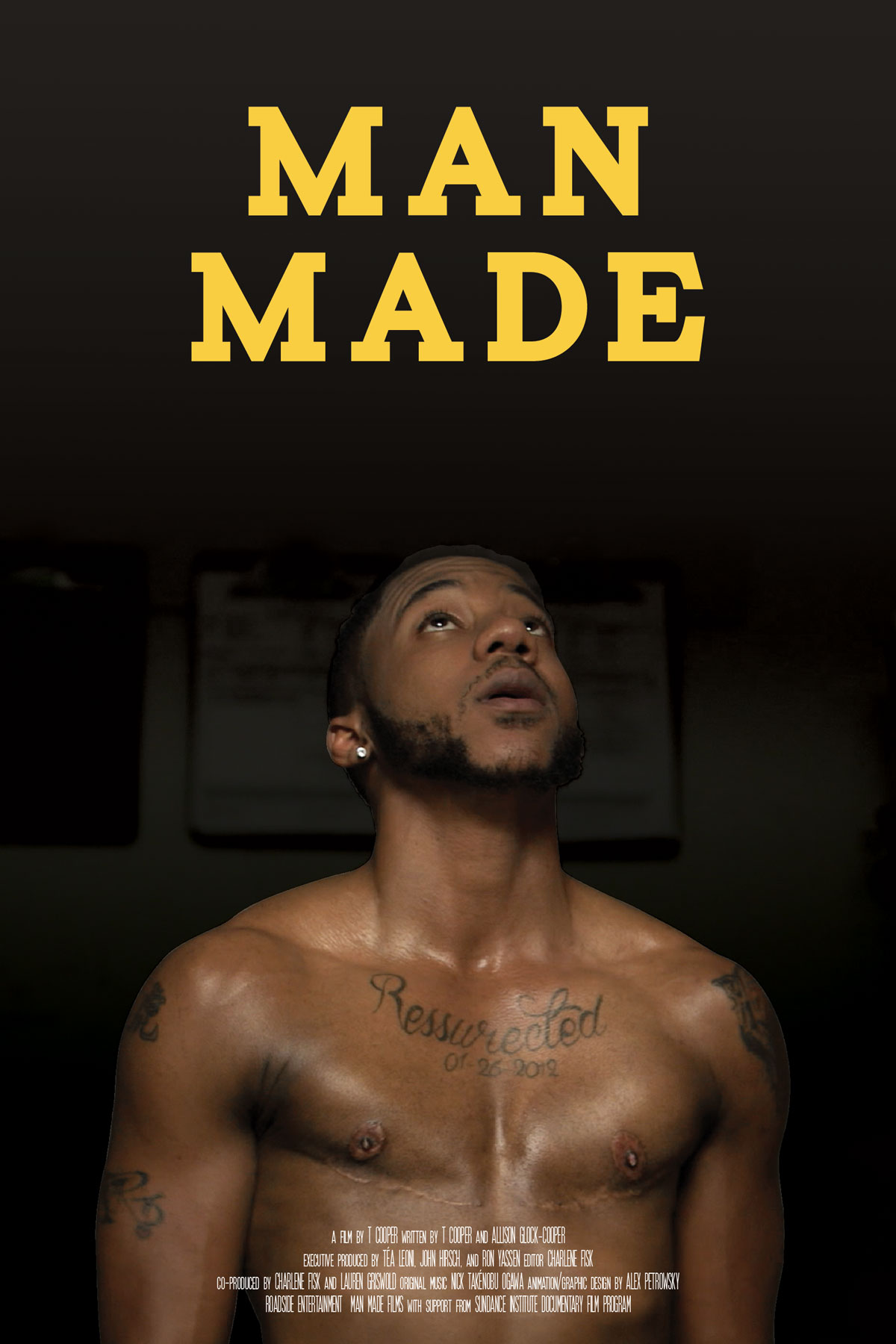
Director: T Cooper
Festival Premiere Atlanta Film Festival (2018)
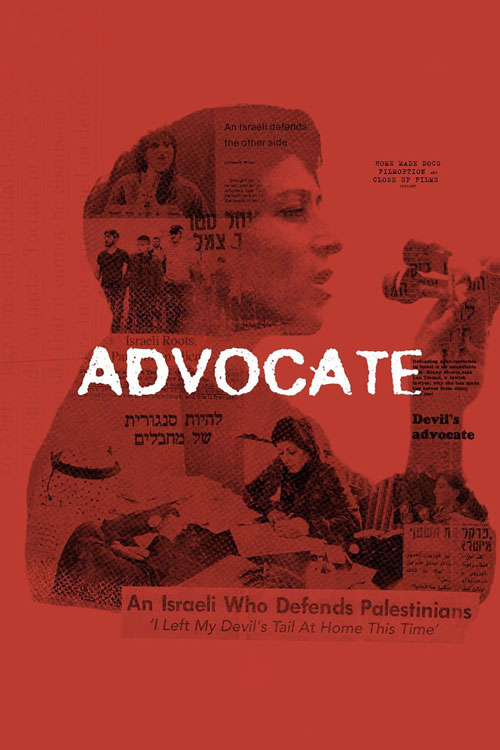
Directors: Rachel Leah Jones, Philippe Bellaïche
Festival Premiere: Sundance (2019)

Anonymous Doc Case Study
’Distributor Divorce Court“
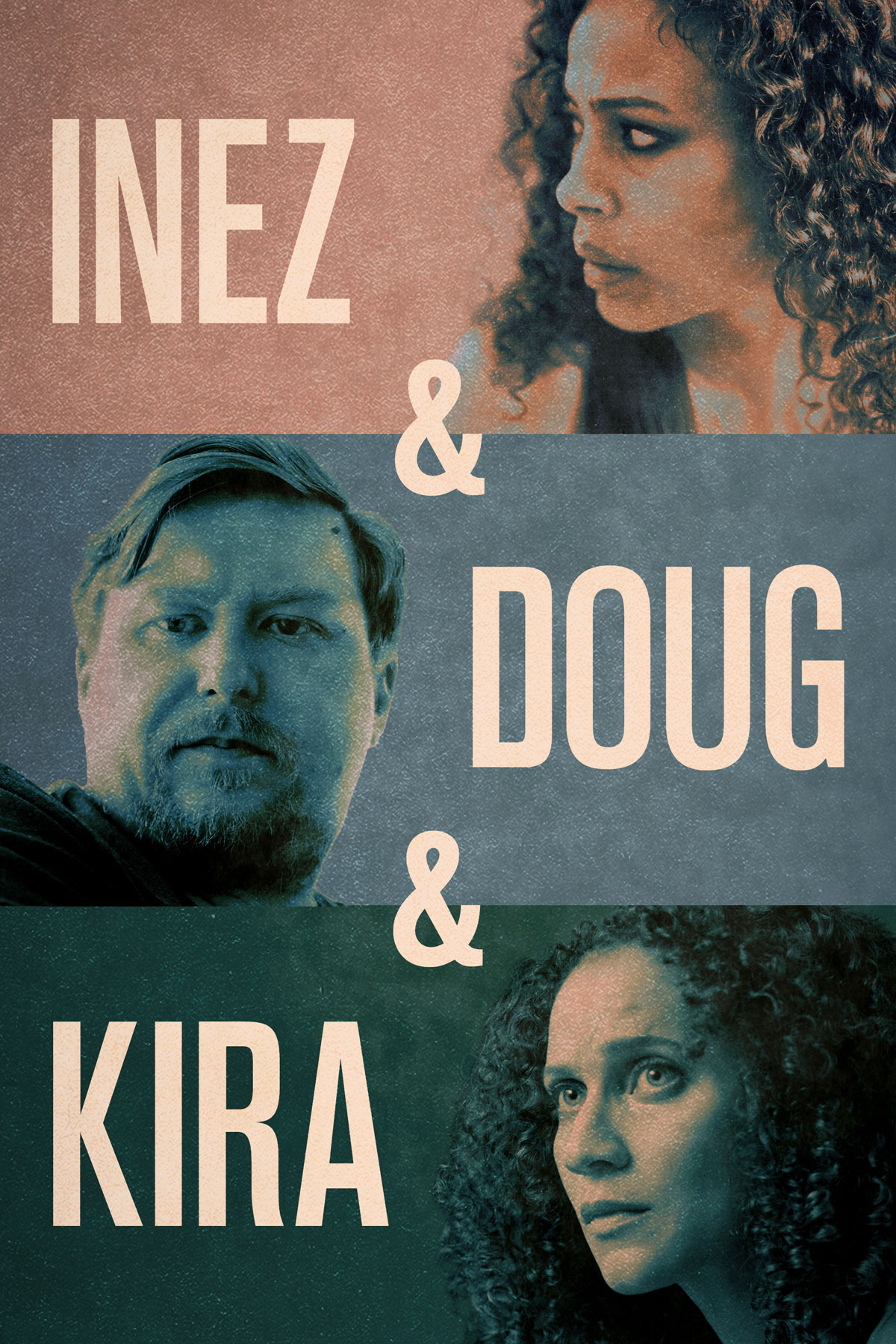
Inez & Doug & Kira
Director: Julia Kots
Festival Premiere: Woodstock Film Festival (2019)
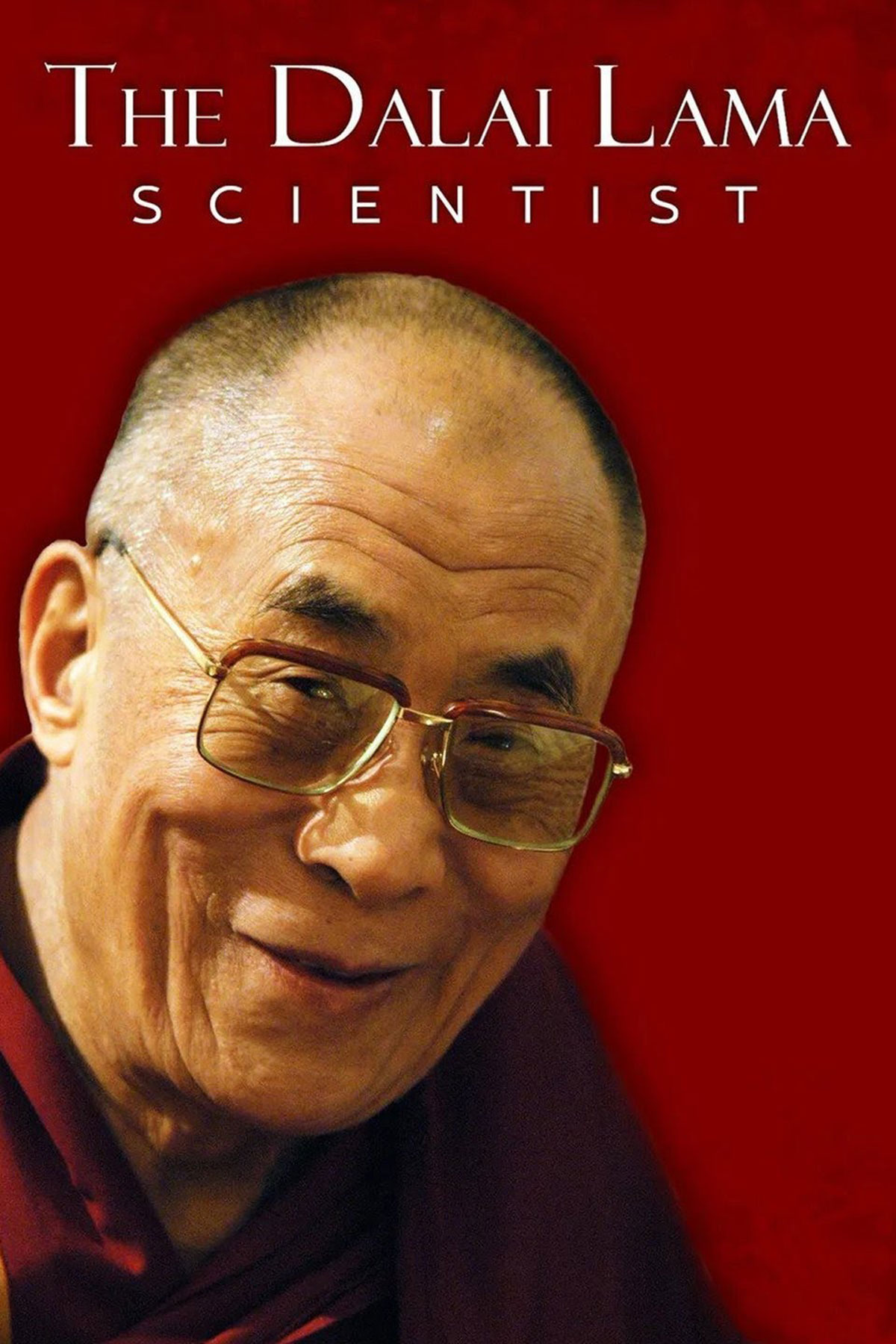
The Dalai Lama: Scientist
Director: Dawn Engle
Festival Premiere: Venice International Film Festival Production Bridge (2019)
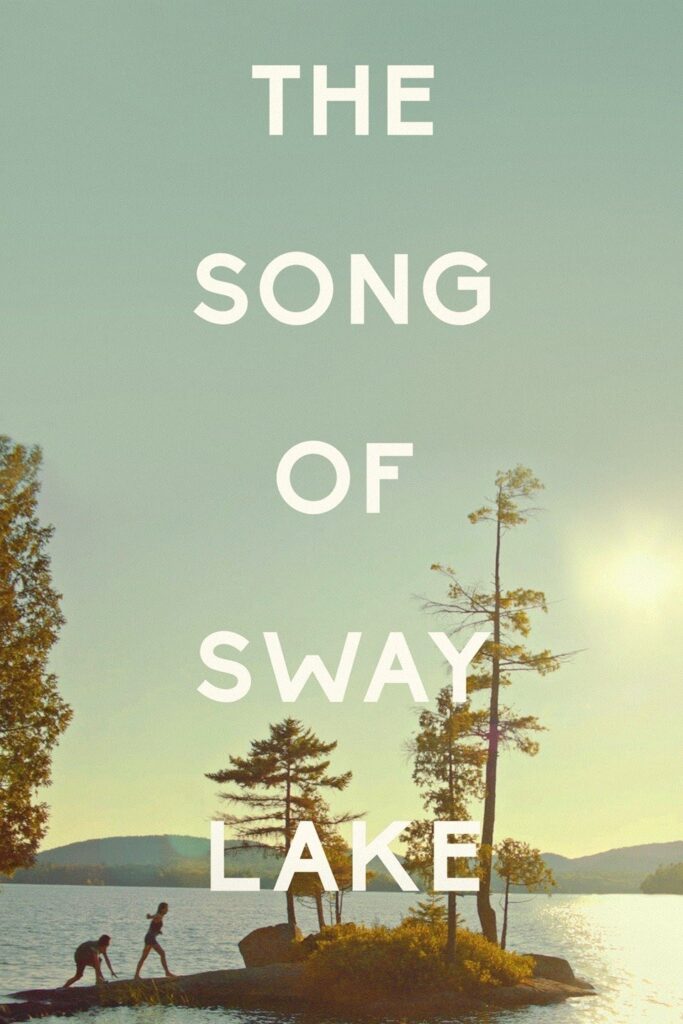
The Song of Sway Lake
Director: Ari Gold
Festival Premiere: Los Angeles Film Festival (2018)
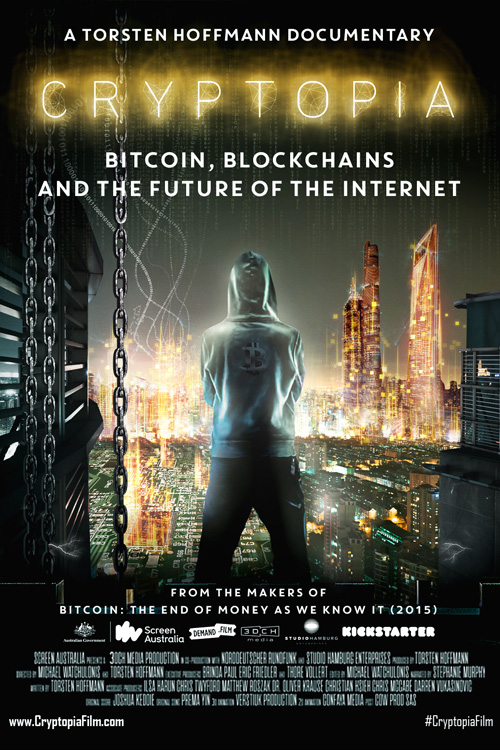
Directors: Torsten Hoffmann, Michael Watchulonis
Notable Festival: Doc Edge, New Zealand (2020)

Director: Lily Zepeda
Festival Premiere: Hot Docs (2019)
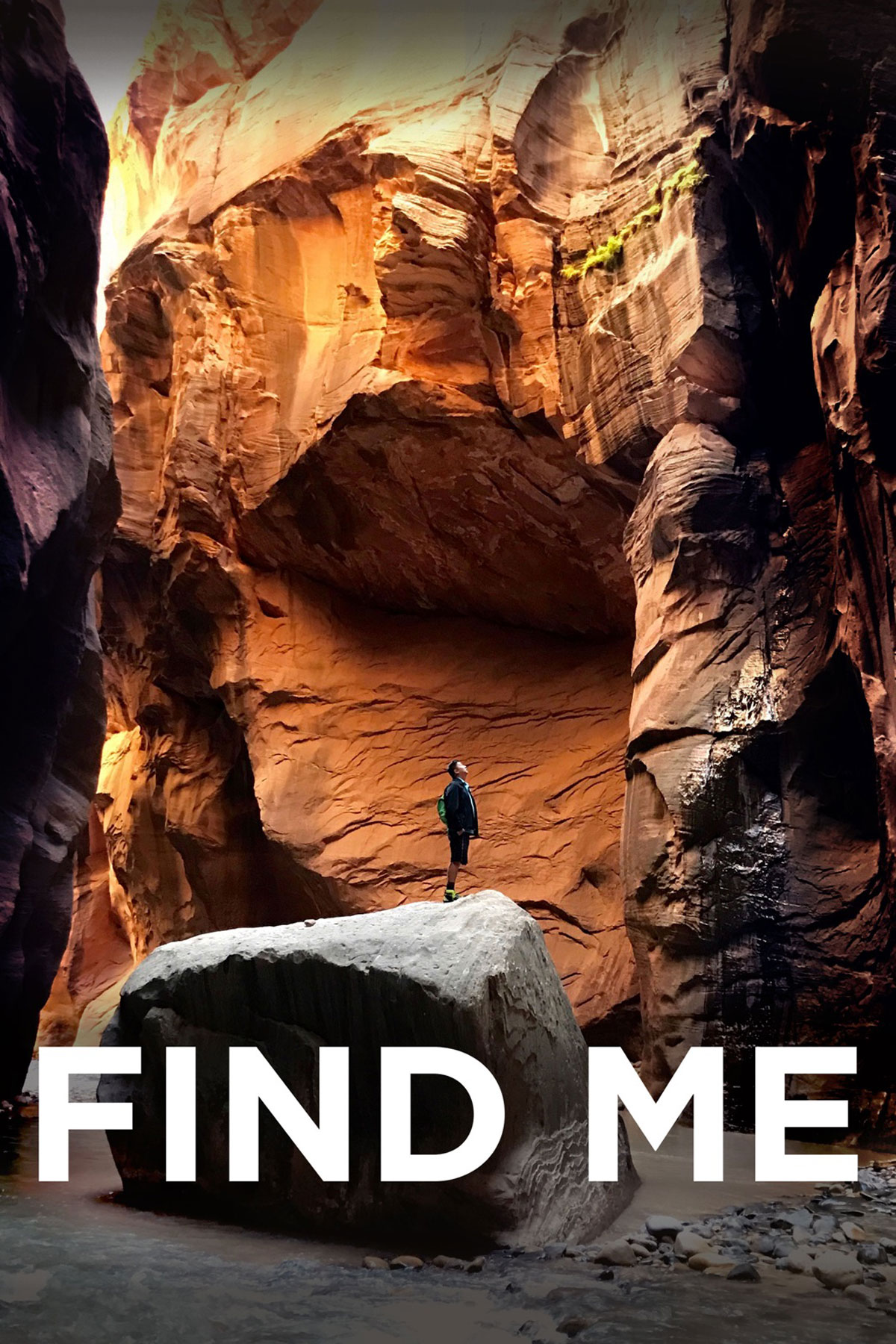
Director: Tom Huang
Festival Premiere: Chicago Asian American Showcase (2018)
Acknowledgements

Social Sciences
The copyright to this article and other articles from JournalQuest are maintained by the publishing journal and/or the individual authors according to agreements set forth by and between the publishing journal and the author. Other materials © 2024 Student Pulse, LLC. All rights reserved. ISSN: 2153-5760.
Disclaimer: content on this website is for informational purposes only. It is not intended to provide medical or other professional advice. Moreover, the views expressed here do not necessarily represent the views of Inquiries Journal or Student Pulse, its owners, staff, contributors, or affiliates.
Home | Current Issue | Blog | Archives | About The Journal | Submissions Terms of Use :: Privacy Policy :: Contact
Need an Account?
Forgot password? Reset your password »

COMMENTS
3.1 LITERATURE CASE STUDY 3.1.1 Pinewood Studios, London Site area : 58 acre Pinewood was built in 1936 on a country estate. New stages, viewing theatres and cutting rooms were added in the 1960s ...
Nirvana Film Studio_©Pallon Daruwalla & Shimul Javeri Kadri. This project, Nirvana Film Studio, is an office space for an ad film production company, designed and built in 2011 in Bangalore city in an approximate area of 8000sq.ft. The ad film company which has produced ads like the Vodafone Zoozoos and Incredible India thinks outside the box and needed spaces that could enhance their ...
118 likes • 54,698 views. P. pratiklalshreshta. This is a thesis on film studio for the degree of Bachelors of Architecture. for more details check the thesis. Engineering. 1 of 121. Download now. Download to read offline. Thesis on film studio - Download as a PDF or view online for free.
Completed in 2015 in Brooklyn, United States. Images by Alexander Severin. Unveiled in Spring 2015, Pratt Institute's new Film/Video Department offers students a cutting-edge facility boasting ...
What role do Case Studies play in a scientific environment? In the medical industry, a case study is a research strategy and an empirical inquiry that investigates a phenomenon within its real-life context. Case studies are based on an in-depth investigation of a single individual, group, or event to explore the causes of underlying principles.
Following the same methodological approach, this chapter locates the business model of Hindi film studios in the new millennium, taking the Yash Raj Films case study (YRF). This new business model, a convergent business model, makes these studios, such as YRF, risk-free, helping them survive even during a crisis like COVID 19.
The facade is also supported with a diagrid along with ETFE panels. The program developed after the case studies of both film studios and high rise buildings incorporates a film school and public Bollywood museum alongside film production making it a mixed typology. The ground cover is 1.1 hectares (30.5%) which is majorly used for service areas.
Case studies ©2020 THIS. FILM STUDIO PTY LTD. All work is produced by or in conjunction with Michael Lawrence and/or Nicholas Cook as part of their work portfolio. ...
When the market shifts, the correct response is rarely to dig in your heels. Instead, it's time to evolve. Cinema has changed distribution, content, and form to survive recent upsets in the market. The case study matters because the movies seem future-proof. After over 100 years of dominance, we can't imagine a world without them.
The Significance and Character of Ar chitectural Spaces in a Film institut e. Rumi Kankariya, 4th year B.Arch, B.K.P .S. College of Ar chitecture, Pune. Dr. Parag Narkhed e, H.O.D. at B.K.P .S ...
For this case study, data collection consisted of semi-structured interviews (Kvale & Brinkmann, 2008) with the director/screenwriter, production designer, and costume designer of a completed full-length narrative fiction film, the pseudonymously named Master Class. The film, which explores academia from the faculty point of view, features a ...
Blog: Tagged Case Studies. Programs Fri 4.8.2022 . SLOAN SUMMIT CASE STUDY: Coded Bias . by Matt Warren. Programs Thu 4.7.2022 . SLOAN SUMMIT CASE STUDY: Tesla . by Matt ... Film Independent 5670 Wilshire Blvd. 9th Floor Los Angeles, CA 90036 T: 323 556 9300 F: 323 556 9303 . We Are.
CASE STUDY: ALGOUS STUDIO . Back. customer story user case. 2020/02/06 . A big interview with ALGOUS studio! CEO Alexei Gusev talks about Russian cinema, the film "T-34", the future of the industry and off-screen difficulties of production and post-production. ... The film company usually hires a single studio, which then tries to work ...
approach, this paper locates the business model of Hindi film studios in the new. millennium, taking the Yash Raj Films case study (YRF). This new business model, a convergent business model ...
The integration of AI into the movie-making process represents a significant shift in how films are produced, distributed, and marketed. From script analysis to audience engagement, AI is ...
In the case of film studio it will be economic to have compact and courtyard planning of workshops as it will be easy to make the sets sequentially. ... - 12 purpose built sound stages ranging from 929 m2- 3576.77 m2 - 200 acre/0.81 km2 green space 32 5.2 LOCAL CASE STUDY 5.2.1 TOM ACADEMY & FILM PRODUCTION STUDIO Tom academy is an award ...
millennium, taking the Yash Raj Films case study (YRF). This new business model, a convergent business model, makes these studios, such as YRF, risk-free, helping them survive even during a crisis like COVID 19. In the book Ideology of the Hindi Film - A Historical Construction (1998),
Find Me. Director: Tom Huang. Festival Premiere: Chicago Asian American Showcase (2018) Acknowledgments: The Film Collaborative would like to recognize the for their generous support in helping us maintain our online educational tools, video series, and case studies.
International case study . 4.2.1. Goregaon Film city . 4.2.2. Pinewood studios . 4.2.3. Filmport Studios . Chapter 5: analysis . ... Fig. 7.5.1 Courtyard between Studios . Fig. 7.5.2 Birds eye view . Fig. 7.5.3 Public Zone ... Film is something that we have been relating with since the day we learned to understand
In conjunction with the destabilization of the studio system and a greater emphasis on directors rather than studios, auteur theory came to command major attention in film theory for the better part of the last several decades as well as dominate critical and public notions of film authorship (Grant 111). ... "A Case Study on Film Authorship ...
Using these features, as compared to featurettes, allows a more comprehensive look at the film and the process. Summary of the production of these films also allows for a more in-depth and look at directors' work, which is more in line with case study analysis. Each case study will provide evidence for each director's production methods.